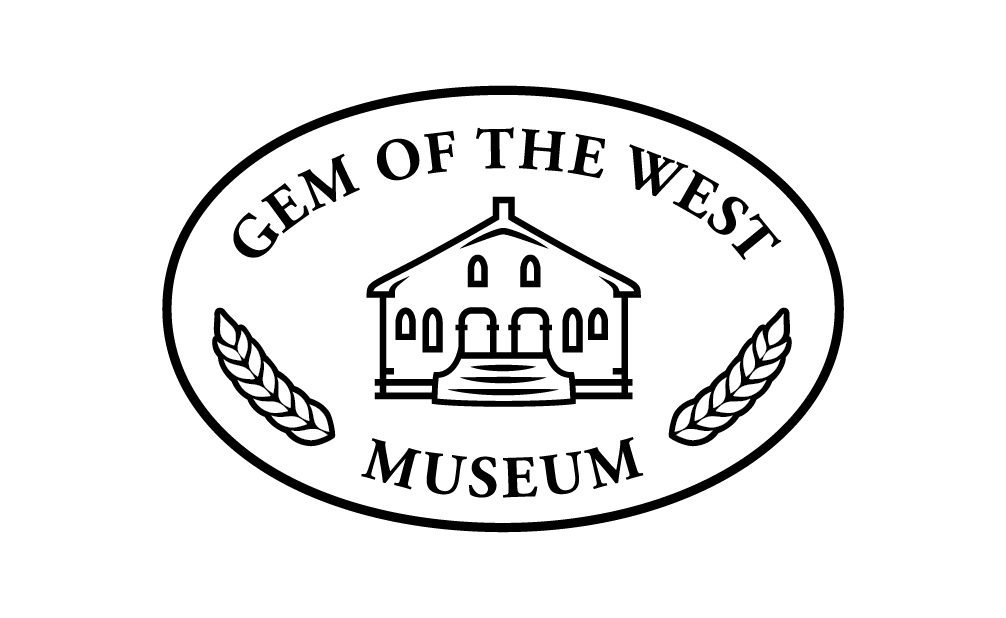Coaldale Heritage Walk
In 2008, a mural depicting the history of the Coaldale Fire Department was painted on the west wall of the Coaldale Fire Hall. That mural, and the one portraying Coaldale Gift Ware, as it was in the 1940’s, sparked an interest in the heritage of our town’s Main Street. In the summer of 2009, discussions of how the community could recognize other buildings of similar heritage, led to the formation of a committee of volunteers to consider options that had surfaced. To be a “heritage site” the buildings had to be constructed prior to 1950. The Committee soon discovered that there were some sixteen buildings along Main Street that qualified.
The Committee delved into the archives of the Lethbridge Herald, Land Titles records, and the 1955 pamphlet on the story of Coaldale, published for the Province’s Golden Jubilee. The “Coaldale: Gem of the West” history book (commonly known as the Blue Book) compiled by the Coaldale Historical Society in 1983, provided valuable information and reflections. Most rewarding for researchers were the interviews with older residents who related their memories of the buildings and their owners/operators. As the research broadened, others came forward with diaries, family stories and anecdotes which added greatly to the accuracy of the information being collected and compiled.
To acknowledge their heritage, plaques which summarize the history of the sites are mounted on each of the buildings. Thus, residents and visitors may easily read the histories as they walk along Main Street. Longer narratives of the many different businesses, and their owners/operators are entered on a computer program in the Gem of the West Museum. More information can be accessed by visiting the Museum, which features a collection of photos of the buildings on display. Having now accomplished these endeavors, the Coaldale Heritage Walk Committee is pleased to invite all interested parties to use these research tools as a way to experience the rich heritage of Coaldale’s buildings and founders.
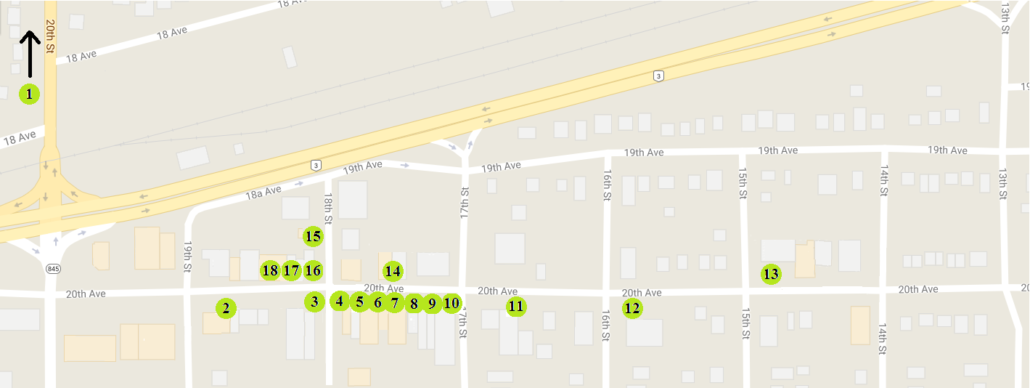
Click on the individual buildings listed below to view images as well as the buildings history.
#1 Mennonite Brethren Church
1306 – 20th Street
Gem of the West Museum
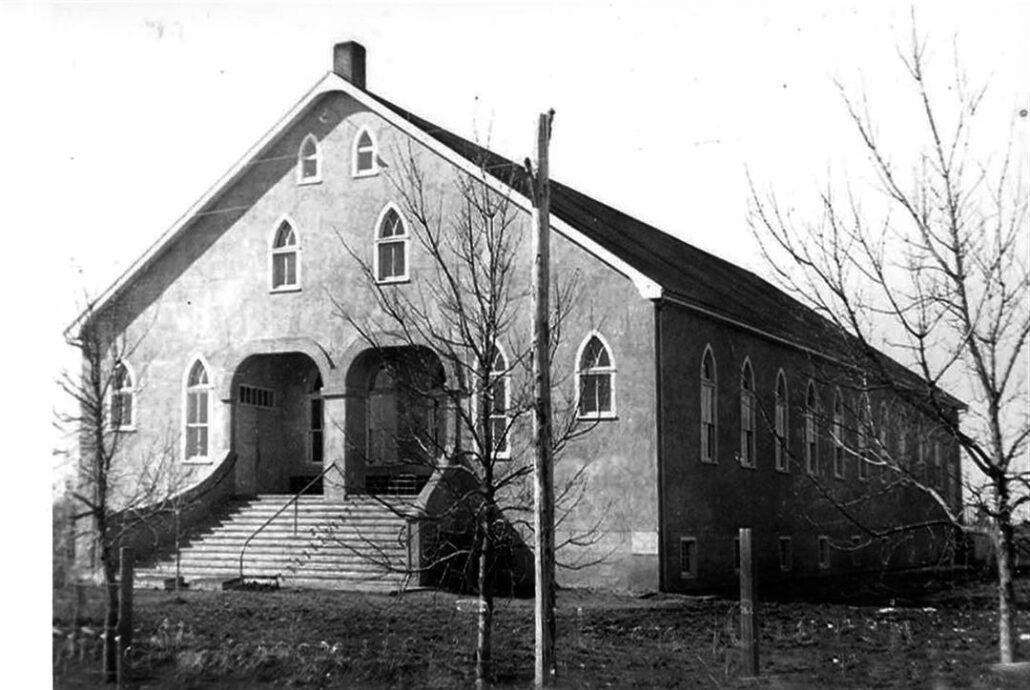
Between 1926 and 1929, the traditionally Anglo-Canadian community of Coaldale – population 1,000 – nearly doubled its inhabitants with the arrival of 600 Mennonite refugees from revolutionary Russia. Escaping religious persecution, they welcomed the settlement and farming opportunities their adopted home offered.
The Mennonites who arrived in Coaldale were of two distinct denominations, Mennonite Conference and the Mennonite Brethren. By May 1926, the latter denomination had organized its congregation and by fall 1928 had built its first church. Almost before the dedication in January 1929, it was realized that the building was entirely inadequate for the growing number of parishioners and before year’s end an addition was constructed. This scenario duplicated itself several times before the main church and all of its additions were dismantled and relocated to varying sites, making room for the 1939 construction of a structure that fully accommodated the congregation’s needs.
This Mennonite Brethren Church, with its natural acoustic sound and amphitheatre-style seating arrangement, served worshippers for the next 32 years. In 1971 growth once again forced the congregation to relocate to a larger, more modern house of prayer.
After sitting vacant for two years, the property was purchased in 1973 by Bill Deptuch. He adapted the structure, including the removal of a major portion of the main level floor, to accommodate the needs of his stonework business. Mr. Deptuch operated L and D Masonry from this location over the next 21 years until 1994, when the building was purchased by the Town of Coaldale as a future museum site.
Home to the Gem of the West Museum since 1995, this significant piece of Coaldale history has been preserved and revitalized through the joint efforts of the Gem of the West Museum Society and the Town of Coaldale, along with the sweat and tears of many, many dedicated volunteers.
#2 Farmer’s General Store
1813, 1813A, 1813B – 20th Avenue
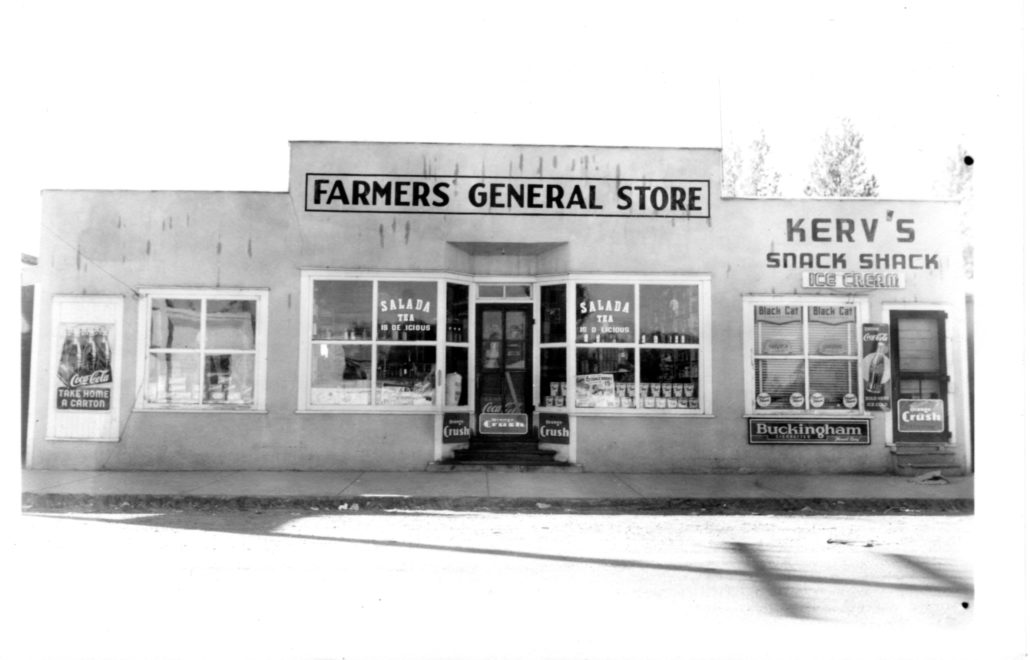
In 1935, when Abe A. Thiessen completed construction of a three-entry building to accommodate both his Farmer’s General Store and a rear-residence for his family, little did he know that the structure would be a Coaldale main street fixture more than 75 years later and still have its original exterior façade.
A Russian immigrant, Abe arrived in Coaldale with his wife Sara and infant son Erwin (Kerv) in 1927. He spent the first 10 years in Canada farming, although unenthusiastic about pursuing this profession he was obligated under the resettlement contract he had signed with Government of Canada. Once the terms were nearing fulfillment however, Abe purchased two 25-foot commercial lots for a whopping $70 to begin the first step towards the realization of his dream …owning a business.
Throughout 1934, Abe and his friend John Baerg, along with a few local carpenters erected a structure with materials purchased from a coal mine in Hardieville. The team of men dismantled unused buildings at the site and loaded the supplies onto a horse drawn wagon for slow transport back to Coaldale. By the fall of 1935 The Farmer’s General Store had opened its doors, with proprietors Abe and Sara working the sales counter over the next 17 years.
The store, which filled the large central space of the three-bay building, operated from 7 a.m. to 11 p.m. Stock was plentiful, with goods priced at the going rate, for example: one dozen eggs – 6 cents, one pound butter – 15 cents, five tins of sardines – 25 cents, three boxes of corn flakes (including a cereal bowl as a prize) 25 cents. The Farmer’s General Store became a gathering place for the community’s older German Mennonite residents, who would gather around the pot-belly stove to reminisce and discuss the latest happenings.
When the Thiessen’s retired in 1951 they retained ownership of the property but sold the business to Takeo and Chito Kimura, who operated the store as Kimura’s Confectionary until 1972. As the Thiessen’s before them, the Kimura’s took up residence in the rear-living quarters. Upon their retirement, Frank Harms re-opened the business as Harms Confectionary, operating it until 1978. That same year the Thiessen’s daughter Loretta and her husband Len Coyne took ownership of the building.
After 39 years as a grocery store/confectionary the new owners oversaw renovations to accommodate the Hair Chalet Men’s Hair Styling and tanning salon operated by Peggy Robertson-Stuckless. In 1995 she turned the business over to Gary Thompson, who operated a hairstyling shop under the Hair Chalet banner for only one year before Renita Van Dyk took the helm in 1996. This business still operated in the building.
On the east and west portions of The Farmer’s General Store Building, small commercial spaces with separate entrances were incorporated into the original design. Through the east door, address 1813 A and the west door, 1813 B many tenants have operated short and long term business endeavors.
The west side was originally occupied by Frank Mish, owner of Mish Photography from 1937 to 1939. After his departure the space remained empty throughout the war years, only to be re-opened in 1947 as Kerv’s Snack Shack, operated by the Thiessen’s teenage son Erwin. With space for only seven stools the slogan ‘We Seat 700 – 7 at a Time’ was created by the young entrepreneur in the first of what would be many business ventures throughout his life.
Between 1949 and 1975 several short-term tenants occupied the space until the Sunny South News relocated to the store-front office from the Loewen building on the north side of the street. The News remained as leaseholder for the next 11 years. For more than a decade after, a revolving list of tenants occupied the west wing. Between 1998 and 2002, Town and Country Locksmith operated by Don Wannop became the next long term tenant, followed by Michelle Berg as Nails and More in 2003. Armand’s Barber Shop now operates in this portion of the building.
From the time the east portion of the building was first rented out in 1951 up to 1986 the majority of occupants have been short-term tenants, with the exception of Art Piechowicz who operated Art’s Barber Shop between 1975 and 1977. From 1986 to 1995 the rear portion of this space was occupied by Alan Graham as Royal LePage Real Estate. The Coaldale and District Chamber of Commerce, under the direction of Lenora Overn and Peggy Stuckless, leased the space between 1995 and 1998. The front office, between 1993 and 2000, was occupied by Kim and Pearl Craig as Investors Group. For a two-year period beginning in 2002, a tattoo parlour operated by Laweny filled the space. Since 2006, E.M.C. Tax and Accounting operated by Jack and Anna Derksen has occupied the east wing.
#3 McFarland Hardware Building
1802 – 20th Avenue
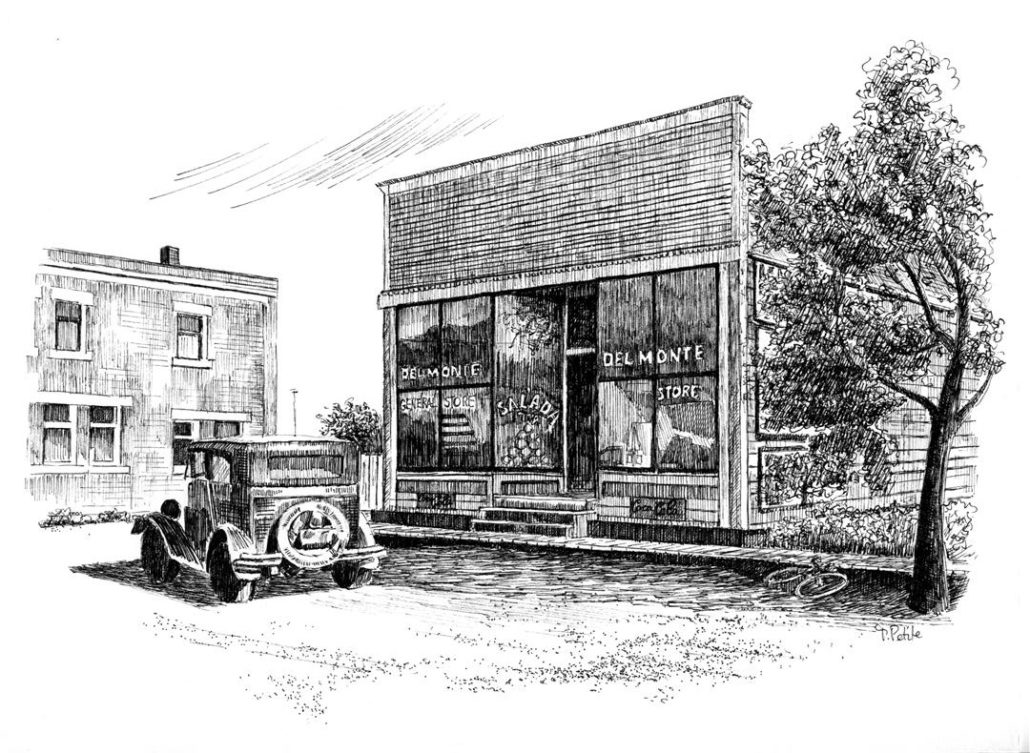
The merchants who have rotated through the McFarland Hardware Building somewhat resemble the characters depicted in the 18th century English nursery verse ‘Rub-a-dub-dub three men in a tub’ – minus all of the rhyming poetry.
A corner anchor on a main street intersection since the summer of 1919, this building may not have accommodated a butcher, a baker, or a candlestick-maker, however hardware, saddle and harnesses, general goods, shoe repair, barbershop, major appliances, garment store and insurance agency meld to tell a historical tale of community life over the past century.
Ninety-two years ago, with Coaldale experiencing a commercial and residential boom, Lethbridge entrepreneur H.C. McFarland expanded his hardware enterprise to the village. He constructed a new building to accommodate a hardware and grocery store, the second in his southern Alberta chain, naming it McFarland Hardware Company. It opened for business in September 1919 and thrived until the fall of 1924, when competition from a similar enterprise located directly kiddy-corner forced the owner to close the doors. Ironically, it was Charles A. Merrick, the competition from across the street who purchased the hardware store’s inventory. The Lethbridge Herald, November 3, 1924 indicates after filling his store shelves to capacity he held a very lively public auction, to disburse of the remaining stock.
By April 1925 Mr. McFarland had leased the building to David King, who relocated his well-established Square Deal Harness Shop to this premise. Lethbridge Herald news reports from the following spring indicate that sales were vigorous with 50 sets of harnesses sold and an extraordinary run on harness repairs. Display counters had also been installed to exhibit a new line of boots and shoes. Within two years of setting up shop in the McFarland Building, Mr. King had his own retail outlet constructed a block further east, thus relocating his harness business in 1927. His business continued to thrive at the new location for the next 26 years, until selling out in 1945.
With Square Deal Harness Shop relocated, the McFarland Building remained vacant for two years. Finally, in December 1929 it was leased to local farmer Klaas Enns, who opened Klaas Enns General Store. He placed the management of his mercantile under the leadership of Johann P. Martens Sr., a relative newcomer to the community who had ample retail knowledge and experience having managed a general store in his native Ukraine.
Johann, his wife Gertrude and six children immigrated to central Canada in 1924, before making their way to Coaldale during the spring of 1929. Mr. Martens, his family and affiliated businesses would remain connected to the McFarland Building for the next 40 years.
By 1932 Johann had secured full operation of the business and renamed it Del Monte General Store. Thirteen years later he purchased the building, which at that time measured 25 feet across by 80 feet deep. Between 1935 and 1939 a partition separated a 50-foot section of the south portion of the floor space. That area accommodated other uses, including Peter P. Wiebe’s Coaldale Shoe Repairing Shop and later a residence for Johann’s son John R., his wife Suzie and their infant son Johnny. Entrance to the south partition was accessed through an east-side doorway.
In 1946, with retirement on the horizon, Johann sold his enterprise to his sons John R. and Peter J. The siblings had played an active role in the business since the time their father became manager, therefore the transition from employees to operators was relatively straightforward. Peter J., today a spry 98-year-old, fondly recalls how as teenagers they were always eager to work the Saturday evening shift. “That is when Coaldale would come alive with people shopping and visiting after a busy week on the farm. It was the best time to be in the store.”
To address consumer demands that coincide with a growing community, the brothers recognized the need for expanded retail space. In 1950 they initiated the construction of a new store by purchasing two vacant lots adjacent to the west side of the original store on which to build a modern premise. By January 1951 the new Del Monte General Store was open for business. In turn, the vacated McFarland Building was leased to Herman A. Smith and his offspring, who for the next year operated the major appliance outlet H.A. Smith and Sons.
In 1952, with an eye to entrepreneurship John R. and Peter J. renovated the McFarland property to accommodate a variety and dry goods business under the Robinson Stores umbrella. Vern Daily was hired as the outlet’s first manager. The following year, the brothers held joint ownership of the property along with their father Johann.
With the Robinson Store relocating to a larger retail space in 1967, the building was leased to Morris H. Danielson, who operated a second-hand business in this locale until 1970. The year previous he had purchased the building from the Martens brothers and their mother Gertrude, widow of Johann.
When Mr. Danielson closed his store in 1970, he sold the property to Herb and Elsie Klassen who established Coaldale Insurance Ltd. The Klassen’s son Howard became joint property owner and business operator in 1983, and secured exclusive ownership in 1997.
During the Klassen’s ownership a section of the office space was allocated for a subsidiary enterprise. Between 1983 and 2008, Coaldale Insurance Income Tax Branch and Book Keeping operated under the direction of Myrna Moulton. Upon Myrna’s retirement, Susan Klassen took over management of this division. Today, Westland Insurance operates in this historical Main Street building.
#4 Greer Hardware Building
1723 – 20th Avenue
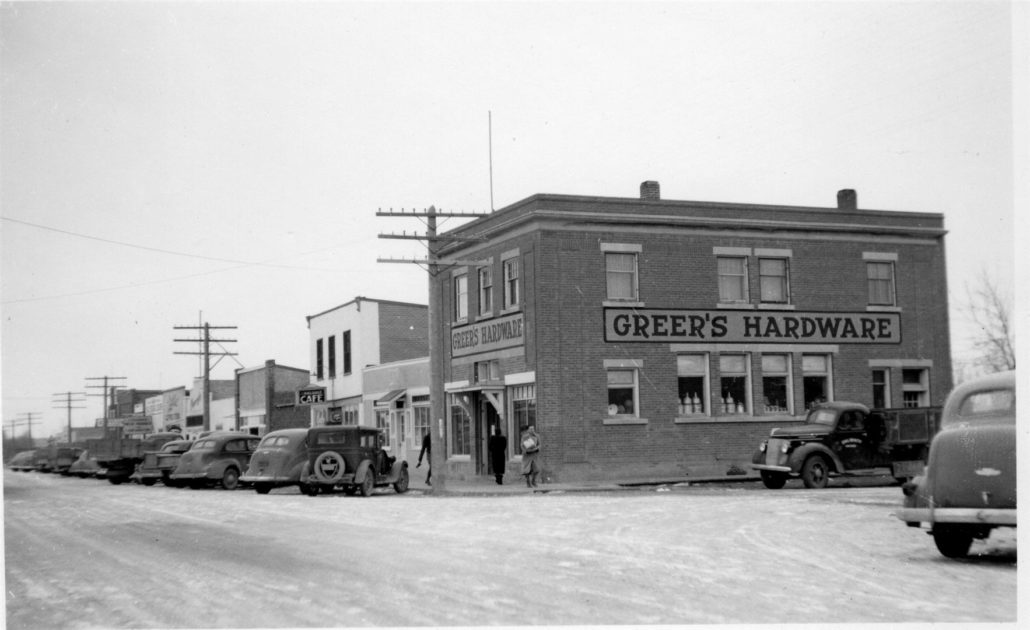
A most dignified two-story brick structure was erected in 1923 on the corner of 17th Street and 20 Avenue, securing a prominent position along Coaldale’s main street for the Standard Bank of Canada.
Village and area residents had originally begun to receive financial services from the Standard Bank in 1919. A devastating fire during the early 1920s in the Hay Growers Hall where the bank was located, closed the branch and disrupted customer service until a new building could be erected. In 1929, just six years after opening this splendid building but with dire economic times on the horizon, the Standard Bank of Canada handed operations over to the Canadian Bank of Commerce . By 1933 the economic times of the ‘Dirty ’30s’ were in full swing, forcing the Coaldale branch of the Commerce Bank to cease operations. All accounts were transferred to the Lethbridge branch.
The arrival of Coaldale’s first physician on November 2, 1933, meant that the bank building would not be vacant for long. Dr. David L. Epp was contracted by the Coaldale Mennonite Health Society (CMHS) to begin work a month after his arrival, establishing the community’s first medical clinic. It was comprised of a waiting room, office and dispensary on the top level of the former bank. The space also served as living quarters for the freshly minted doctor and his new bride Rosella.
Up to that time, Coaldale residents requiring hospital-level medical care were admitted to either St. Michael’s or the Galt Hospital in Lethbridge. However, with a physician firmly placed in the community the CMHS began planning for the establishment of a local hospital. On February 12, 1934, less than three months after the village’s first clinic was opened, the main level of the Standard Bank building was dedicated as Coaldale’s first hospital. Used mainly as a maternity hospital, the front portion of the subdivided space contained offices and a waiting room, with the two back rooms dedicated to the delivery room and hospital ward.
It did not take long before the demands on the medical facility proved the space to be entirely inadequate for the needs of a growing community. The search was on for a new location. By February 3, 1935 – less than a year after accommodating Coaldale’s first hospital – a new facility had been dedicated and the Standard Bank building was vacant once more.
Within weeks, businessman Roy Greer had purchased the bank building for the princely sum of $1,200, initially using the space for the Village of Coaldale and Coaldale School Board offices. Soon after, he established Greer’s Hardware, a family venture involving his wife Eva, and daughter Elma (Babe) as manager and chief purchasing agent. After serving in the armed forces, son Gordon returned in 1946 to take over the store’s management.
The second story of the hardware store remained converted as residential space, with Greer’s daughter Rhoda (Toots) and husband Ira Holtman living in the apartment following their marriage. Many other family members resided there over the years. A Greer grandson fondly reflects on the excellent vantage point the two story structure provides for viewing Coaldale’s annual parade, not to mention water balloon ‘bombings’ of passersby on the sidewalk below.
In 1962, both Eva and son Gordon passed away. Unable to manage the business on his own, Roy closed the doors, bringing to an end 27 years of valued customer service.
For a five-year period between 1963 and 1968 the premises were rented to Orlando Martens, who had converted the space to accommodate his professional photography studio. By 1969 local pharmacist Rudy Gettman and his wife Marj held title to the Greer Hardware building. Within a short period of time they had purchased the former Coaldale Barber Shop and the McCann Drug & Sundries property located adjacent to the Greer building’s east side. The new proprietors undertook major renovations to combine all three buildings into a single store and reopened as Coaldale Pharmacy. The restoration included an expanded pharmacy, drug and gift retail shop.
Two decades later, pharmacist Dave Cruickshank and his wife Carol purchased the business. In 1997, following the relocation of the Coaldale Pharmacy to a new Main Street location the couple established Coaldale Giftware & Antiques. Coaldale Ladies Wear is now established in this iconic Main Street building.
#5 Coaldale Barber Shop, McCann Drug Sundries Building, Greers Hardware Building
1719, 1721, 1723 – 20th Avenue
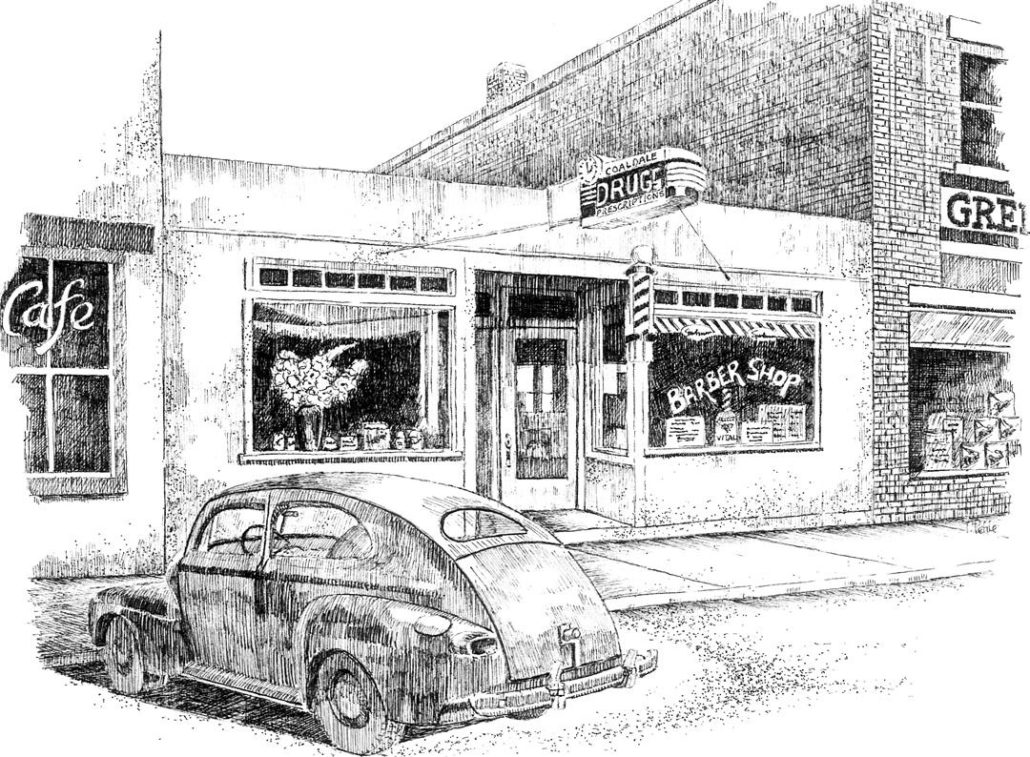
George Peck, an apprenticed barber who perfected his skill in his Hungarian homeland, plied his trade across Western Europe and the United Kingdom prior to his 1923 arrival in Coaldale, where he leased a chair in Smith’s Pool Hall.
Within two years Mr. Peck had purchased land directly east of the Standard Bank, a stately two-storey brick structure situated on the corner of 1723 20 Avenue. On the 1721 designated property he constructed a small building, from which he operated Coaldale’s first stand-alone barber shop. Over the ensuing 25-plus years the popular barber ensured the men of the community were well groomed. In the mid-1950s, when retirement beckoned, he retained the property ownership but sold the barbershop businesses to Art Piechowicz who continued to service clients in that location until the early 1970s.
Mr. Peck, always the visionary, could see the potential for additional businesses in the growing community. In 1947, to accommodate the aspirations of entrepreneur Peggy McCann, he built a small structure on land flanking the east boundary of his barber shop. The property was designated 1719. The small space, leased to Mrs. McCann, housed the early days of the McCann Drug Sundries. With $1,200 in hand, half used to fix up the interior of the new store and the balance used to purchase stock such as gift cards, magazines and dry goods, she was on her way to what would be a 20-year career. When the post-war boom brought additional growth to Coaldale, Mr. Peck expanded both buildings. In turn, Mrs. McCann was able to contract with a pharmacist and developed her operation into a full service drugstore offering a wide variety of consumer goods, in addition to full pharmaceutical services.
In 1963, Rudy Gettman joined the staff as the resident pharmacist. On January 1, 1967, upon Mrs. McCann’s retirement, he and his wife Marj purchased the business and the Coaldale Pharmacy was born. Two years later, on the expiration of their original lease, the Gettman’s acquired the drug store and barber shop buildings from the George Peck estate. That same year they also purchased the former Standard Bank property, which had once housed Coaldale’s first doctor’s office, dispensary and for a brief period of time its first hospital. To most Coaldale old-timers however, it will always remain Greer’s Hardware, operated by Roy and Eva Greer for 34 years between 1934 and 1968.
In 1972, with land titles secured on all three properties – 1719, 1721, and 1723 – the Gettman’s undertook major interior and external renovations to bring the properties together under the single entity of 1723 – 20 Avenue. The completed result was an expanded drug and pharmacy, along with a wonderfully enhanced gift shop and an attractive street side exterior.
Two decades later, pharmacist Dave Cruickshank and his wife Carol purchased the business. In 1997, following the relocation of the pharmacy the Coaldale Giftware & Antiques was established in the former drug store, with yet another popular retail business to anchor the commercial sector of 20 Avenue and 17 Street. As of 2018, Pizza Hut has occupied this space.
#6 J.J. Leffler Building
1715 – 20th Avenue
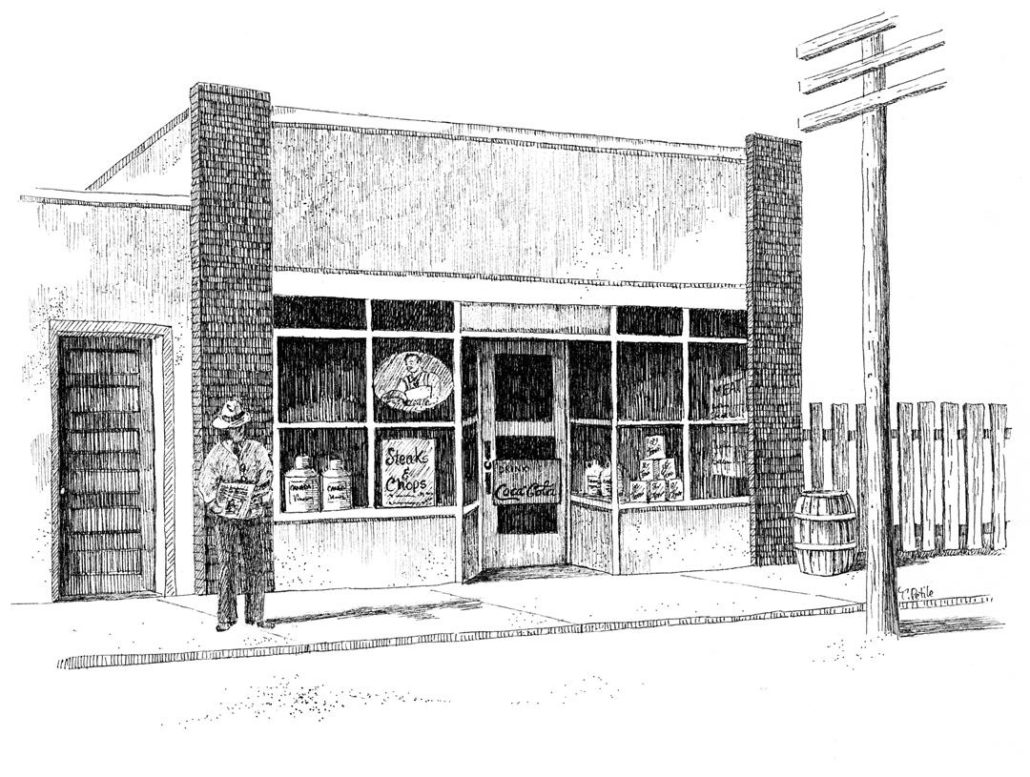
As with most buildings associated with a historical walk, if walls could talk, we would be amazed by the stories. Such is the case with the proprietors and leaseholders who have occupied the J.J. Leffler Building since its 1919 construction.
Jethro J. Leffler, a veteran of the Spanish-American War, was a Macon County, Missouri high school teacher, who in 1910 immigrated to Canada and began farming in the Coaldale area. Within a few years he was the local Southern Alberta Co-operative Association manager. In addition, he built, owned, but never occupied a substantial brick building that he leased out to an array of businessmen – all plying the same trade – over the next 16 years.
In 1899, William Arthur Grunewald was an Idaho homesteader, whose property bordered the Nezperce Indian Reserve during an era when settlers were being burned out. Fortunately, for him and his young family, the Indians took a liking to them and they never experienced any harm.
In 1918 William fulfilled his lifelong dream of farming in Canada by relocating his family to 90 acres of virgin land two miles east of Coaldale. His first crop failed due to poor weather. In 1919 he decided to pursue the meat butchering business, joining his wife Cassie, who had opened a small ice cream parlor and grocery store in a building she rented from Jethro Leffler. Three years later the couple sold their business to Stanley Smith, who opened the Coaldale Meat Market in the leased building.
Mr. Smith had immigrated to Canada from his native England in 1907, first working as a farm laborer and then as a butcher in the Cardston area. By 1914 he was the head butcher at the Bennett Store and later the Delaney Meat Market, both located in Lethbridge. World War I took him back overseas, but upon his military release in 1919 he made his way back to southern Alberta, residing on a C.P. R. soldier settlement farm north of Coaldale. In 1921 he returned to the butchering business, first opening a meat stall in the R.J. Baldry grocery store, followed by his purchase of Mr. Grunewald business in 1922.
Within a year Stanley was back farming in the Spring Ridge area, while his sons Jack and Harold were running the butcher shop. They renamed the business Smith Brothers Meat Market. His daughter Dorothy became proprietor of the ice cream parlor, which she continued to operate until her marriage in 1927. The brother’s partnership remained intact until the early 1930’s, dissolving when Harold purchased his own farm.
R.S. Lawrence, an English engineer who had arrived in Coaldale in 1920, was employed by the Irrigation Branch of the C.P.R. Department of Natural Resources. He bought Mr. Leffler’s building in 1935; however research has failed to reveal exactly what he used the space for. Two years later he sold the building to Lucy Nelson, who undertook major interior renovations before opening Lucy Nelson’s Coffee Shoppe.
A resident of Coaldale since 1920, Mrs. Nelson was known in the community for her gardening talents and menagerie of pets she kept in her yard. As her husband Norman’s work with the Alberta Wheat Pool kept him on the road a good deal of the time, she opened her coffee shop as a means to pass the time. During the war years, a time when sugar was rationed, she posted a sign which read, “Use less sugar, stir like hell, we don’t mind the noise.” Seeking new adventures, in 1942 she leased the building to R.E. Baldry for the community’s post office.
In 1944 the building was purchased by H.A. (Herman) Smith to house his latest business venture. As the owner of Coaldale’s first pool hall 25 years earlier, a town councilor and mayor, and among the founders of the grocery co-op, he was always looking for a new venture. He established and operated H.A. Smith and Sons, having been joined by sons Leon, Floyd and Ed. From this location they operated a John Deere Agency, plus serviced and sold radios, along with electrical appliances for the next 15 years. In 1960, Ed purchased the property and business along with partner Mike Miskulin. They rebranded the store to Smith’s Radio and TV.
With the invention of the television Smith’s became a popular destination for the community’s children and adults alike, who would line up outside for a chance to peer through the window to watch ‘the tube’ for the very first time. Youngsters were often invited in to watch Saturday afternoon programming. In 1978 the business was relocated to 13 Street North Lethbridge, where it continues to operate today.
After sitting empty for several years, in 1980 the building was purchased by Kay and Dick Allison, who operated Sew Fine Fabrics for six successful years, before selling to George Fujikawa. Renovations ensued and when the space reopened in 1986 it became Fudges, a popular lunch and coffee shop. Three years later, the restaurant was leased to Tina Williams, who continued to operate Fudges for the next six years. Two more proprietors ran eateries in the building from1997 to 2001, those being Frieda Neufeld with Frieda’s Kitchen, followed by Bonnie Biddlecomb’s restaurant Biddlecomb’s.
In 2001, the 80-year-old J.J. Leffler Building became the property of Tim McLennan. He leased the space to his original tenant Linda Nesting, owner of Linda’s Flower Magic.
#7 Alfalfa Billiard Hall Building
1711 – 20th Avenue
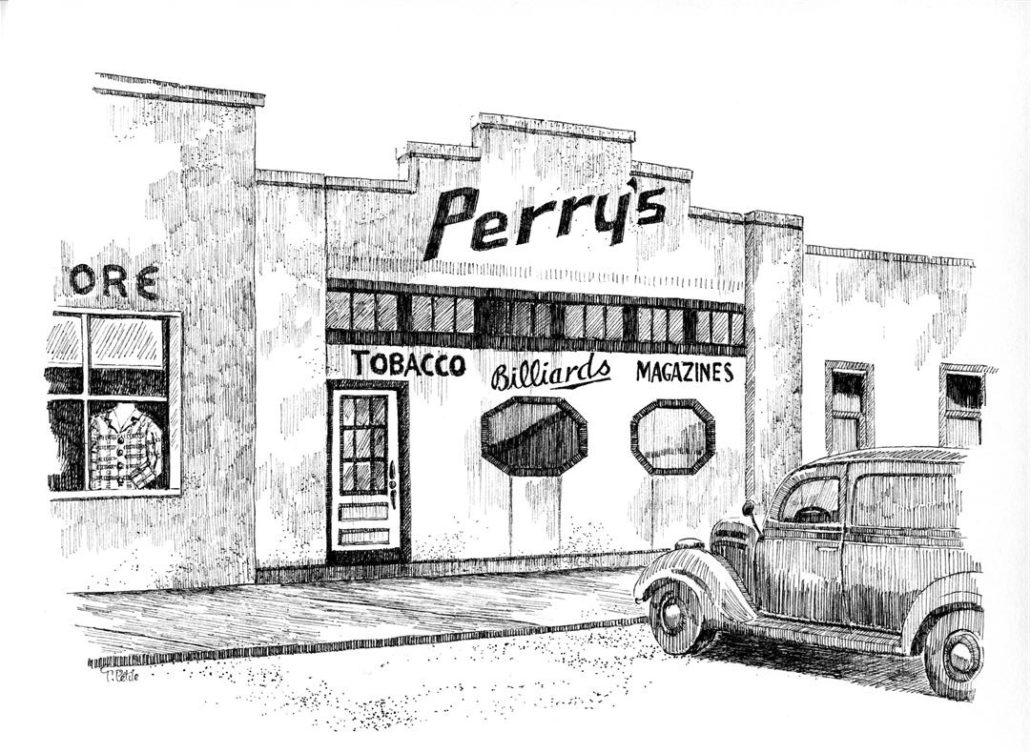
Herman A. Smith, traditionally referred to as H.A. by all who knew him, was a community-minded individual who participated in local politics and business. In 1919 he arrived in Coaldale from North Dakota following a brief stopover in Bow Island, where he had owned a pool hall.
Falling back on his billiards knowledge H.A. built Coaldale’s first pool hall, the Alfalfa Billiard Hall in 1920. Located on the south side of Main Street, between Third and Second Avenues, Herman’s establishment soon became the place in town for the men to “hang out” playing pool or the slots. A further attraction to the locale came in 1923 when George Peck set up his first barbershop in the northeast corner of the pool hall.
When H.A. wasn’t mingling with the locals in his pool hall or other business endeavors he was engaged in political affairs, serving as a Village of Coaldale councillor, reeve and mayor. He was also the secretary-treasurer of the Coaldale and District Telephone Company. He was personally involved in local sports including curling and his great love – baseball.
By 1928 Herman Smith had expanded his business enterprises to include the John Deere Agency, using the rear of the Alfalfa Billiard Hall as a storage yard related to the Agency operation. He continued to operate both ventures through to 1944, at which time Mr. Smith chose to focus on an expanded Agency business and sold the billiard hall to Ray Perry. He renamed this community attraction Perry’s Pool Hall.
Perceiving a potential for increased business, Mr. Perry extended the building space to accommodate three additional ‘snooker’ tables, along with a confectionery and smoke shop at the front of the establishment. About this time, the pool hall became the Coaldale depot for the Greyhound Bus Lines.
Sixteen years after becoming proprietor of Coaldale’s pool hall, Ray Perry retired and sold out to Mr. and Mrs. Mori, who continued to operate the business in much the same style as patrons were accustomed.
The Mori’s became known for their unique flair, where they became Main Street fixtures commuting to work in their ‘59 Lincoln Continental (green if memory of one local school boy is correct). Their HUGE, dark brown watch dog slept peacefully near the end of the front counter. Upon hearing Mr. Mori’s whispered command; he would join in settling any dispute amongst the ‘pool sharks.’ These clients engaged in games of snooker, golf, eight ball, poker pool or any of a myriad of games invented on the felt covering the slate and polished wood tables.
In 1963 a concrete block addition was erected at the south end of the building to contain new washrooms and a storeroom. The Mori’s sold the pool hall in 1976 to J. & W. Vending owned by the McLennan’s. Within one year of taking over the business, the pool hall was closed and remained shuttered until 1982. That year, Jim and Tim McLennan reopened it with pinball machines joining the pool tables for fun and games. The building also served as headquarters for the J. & W. Vending Company. In 1999, following extensive renovations, which replicated the classic look of the pool hall right down to the old fashioned Coca Cola, Orange Crush and Pepsi signs, Tim McLennan added a lounge area and renamed the business McLennan’s Cocktails and Cues.
As business grew at the popular nighttime spot, Tim McLennan recognized the need for increased space. In 2005 he expanded the pool hall and lounge into the adjacent westerly building (formerly 1713 – 20 Avenue) developing proper kitchen capacity and business office space.
#7A Vacant building
1713 – 20th Avenue

No longer obvious as a separate building
Until 1944, when R.E. Baldry built and opened a full service post office on the site, this property had remained vacant since the settlement of Coaldale in the early 1900s. This mail service outlet served the community until 1954 when a larger facility was opened just off Main Street at 2007 – 18 St.
Following the relocation of the post office through to 1977 this building housed a variety of business, including a mechanic’s shop in the early 1970’s. In 1977 Peter and Lydia Martens bought the premises, opening Square Deal Construction and Martens’ Real Estate, which operated from this location over the next decade. In 1986 Remax Realty occupied the storefront, followed a few years later by the law firm of Lammi and Boras Law, with the final tenants Derksen and Foxall Accounting.
#8 Square Deal Harness Shop
1709 – 20th Avanue
Leonard Fast Law Office
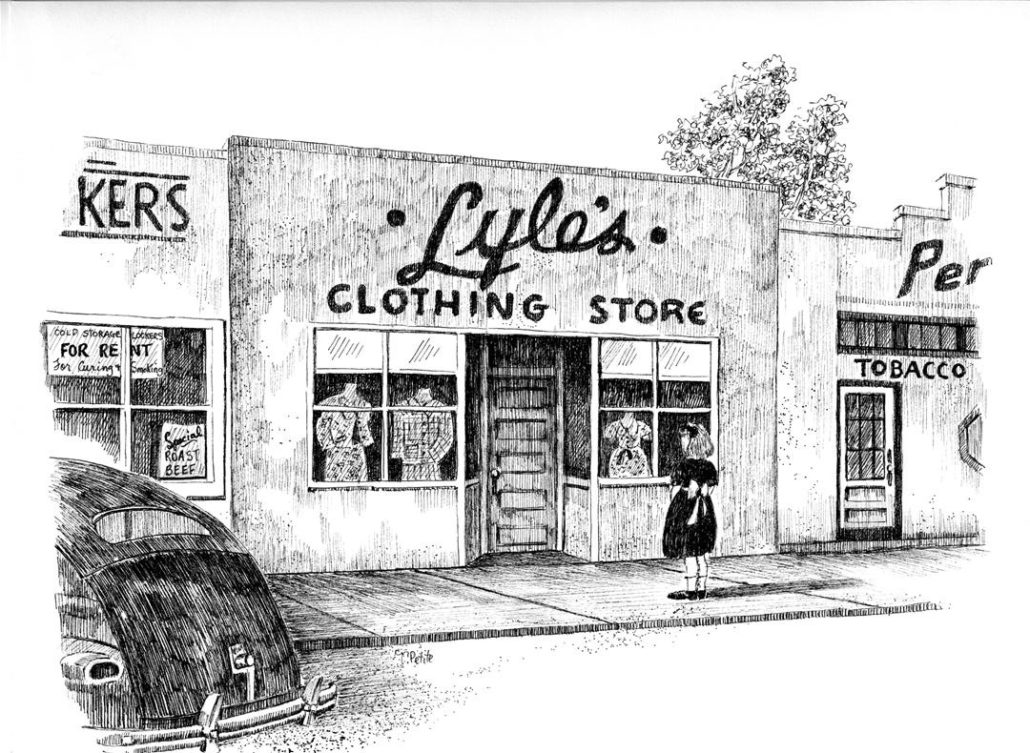
This building evolved from a saddle and harness shop during the horse heydays of the late 1920’s to a men’s work wear outlet after the advent of the tractor made the harness business redundant. Five decades later it was reincarnated as a professional office. David King – the Village of Coaldale’s first reeve – would be astonished to see the changes his Square Deal Harness Shop has gone through since its original construction in 1928.
The first mention of David King operating a harness shop is referenced in the Lethbridge Herald Archives of February 17, 1919 with an announcement that an old hay warehouse near the McLean School had been fitted up for his use. On March 19, 1919 the archives indicate that David King’s Square Deal Harness Shop was in full swing and an April 11, 1919 follow up announcement indicated he was relocating the business to a place he had purchased one mile north of Coaldale. By April 28, 1925 it was reported that Square Deal Harness Shop’s business was steady and Mr. King had relocated to the McFarland Building, currently the Coaldale Insurance outlet.
In 1927, with business continuing to grow and an expansion into men’s work wear, David King, a man who had a penchant for business, community service and good fun, was constructing a new building. The Square Deal Harness Shop was relocated to a single lot on the south side of Main Street between Herman A. Smith’s billiard hall and R.J. Baldry’s store. The structure measured 25 feet by 50 feet.
For the next 26 years he attracted customers to his shop at this location, not only to purchase the goods he sold, but also to play penny ante card games that were always underway in the back room. During blustery winter months the store’s heated space was an added attraction, as it provided a reprieve from the cold, along with a chance to win some pocket change.
In 1945 the business was sold to Lyle Fairhurst – proprietor of the Coaldale Hotel, who renamed the shop Lyle’s Clothing Store. Over the next 22 years he operated a successful men’s clothing wear store. Renovations to the interior of the building included the installation of plasterboard on the walls. During his ownership the business sponsored the local fastball team, Lyle’s Rockets, which played in a very competitive league.
Following the closure of Lyle’s Clothing Store in 1967, the building ownership transferred to Herman Kastner, who operated Herman’s Upholstery from this location for the next five years. In 1972 he relocated to a larger building directly across the street, as he had added carpet sales and installation to the business.
In 1976 the building ownership shifted once more, changing from long-held retail to a professional office. It was purchased by chartered accountant Jack Neufeld and lawyer Leonard Fast, who held joint tenancy for their individual businesses. In 1994 Neufeld Jack M Professional Corporation relocated to a new site. In 2007, Leonard Fast Professional Corporation acquired the entire property, with Fast operating his law firm from this location for over 40 years.
With additional office space available in the building, portions have been leased to other businesses over the past number of years, including the Canadian Organization for Rare Disorders and Robinson Agencies, an insurance agency.
In some aspects 40 years does not seem like a long time ago. However, if you consider the fact that in 1976 when Leonard Fast and his partner first hung their professional shingles on this building, there still was a pot-bellied stove heating the office space. Now that does make it seem like eons ago.
#9 Coaldale Meat Market Building
1707 – 20th Avenue
Wiebe’s Delicatessen
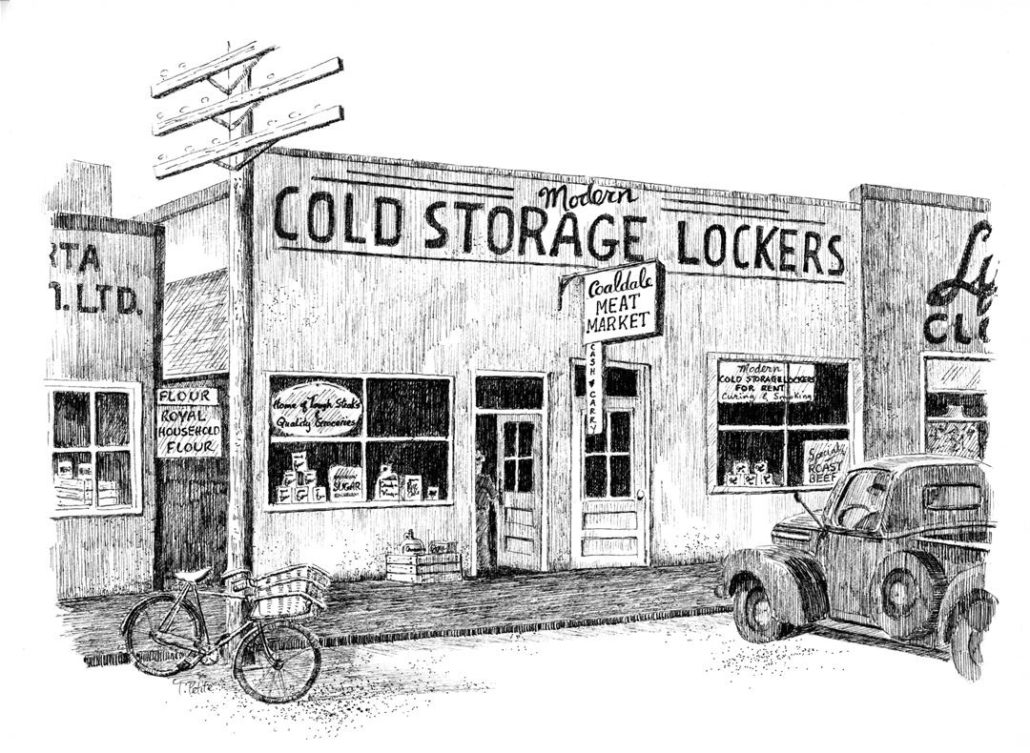
In late 1933, a surplus of Thanksgiving turkeys on the family farm and a penchant to return to main street commerce prompted Jack Smith to leave agriculture behind and return to the meat market business. It had originated in Coaldale with his father’s one-day-a-week stall located in the R.J. Baldry Pioneer Store.
Stanley, the Smith family patriarch, was a professional butcher who settled on a farm north of Coaldale in 1919. On November 18, 1921 the Lethbridge Herald Archives reported that he had opened up a Friday-only business in the Baldry store. By January 11, 1922 news reports noted that he had started a full-scale butcher business known as the Coaldale Meat Market in the J.J. Leffler building up the street further west. Within a year, sons Jack and Harold, having learned the trade from their father, had taken over the butcher shop, renaming it Smith Brothers. They continued to operate the business from that locale for nearly a decade.
Following his brief venture into agriculture, Jack Smith had a building constructed to house his new Coaldale Meat Market, moving into the premises on February 4, 1934. For more than 85 years the Coaldale Meat Market has thrived at this location under the directive of three ownerships and only two name changes.
By the spring of 1936, within two years of opening the self-contained butcher store, Smith added an annex to the east side of the structure to accommodate the Coaldale Cash Grocery, a food and quality dry-goods outlet operated by his sister-in-law Jessie Nolan. In 1941, with business flourishing he expanded the shop once again. Concrete was poured on January 10 of that year, in preparation for the installation of a freezer storage plant that would contain 163 of Alberta’s very first locker boxes available for rent to patrons.
With his calendar slogan proclaiming the Coaldale Meat Market as home of ‘Tough Steaks and Quality Groceries’ Jack Smith’s business flourished under his tenure. In 1949, after 15 years in business at this location proprietor Smith made the decision to sell and ownership was turned over to Myron Rak, the former Assistant Superintendent of Intercontinental Packers in Saskatoon.
During Mr. Rak’s tenure another expansion to the freezer plant was initiated, with lockers 164 to 299 added for customer convenience. He was a businessman who had an affinity for good conversation and a reputation for helping customers during tough times. He employed many local schoolboys over the course of his 34-year ownership, including current meat market owner John Wiebe.
Following his death in 1983, Mr. Rak’s widow approached John, who had pursued a career in the meat trade, about taking over the business. With a desire to return to his home community and an opportunity to run his own business, John welcomed the offer to be the next proprietor of the well-established business. John ran the business for over 30 years as Wiebe’s Sausage Works. Today, the business pays tribute to John by continuing under the Wiebe name as Wiebe’s Delicatessen.
Over eight decades have passed since sawdust first covered the oiled wooden floors of the Coaldale Meat Market, yet even today under the Wiebe brand the historical character of the butcher shop remains. Jack Smith would be proud!
#10 Southern Alberta Co-op Building
1705 – 20th Avenue
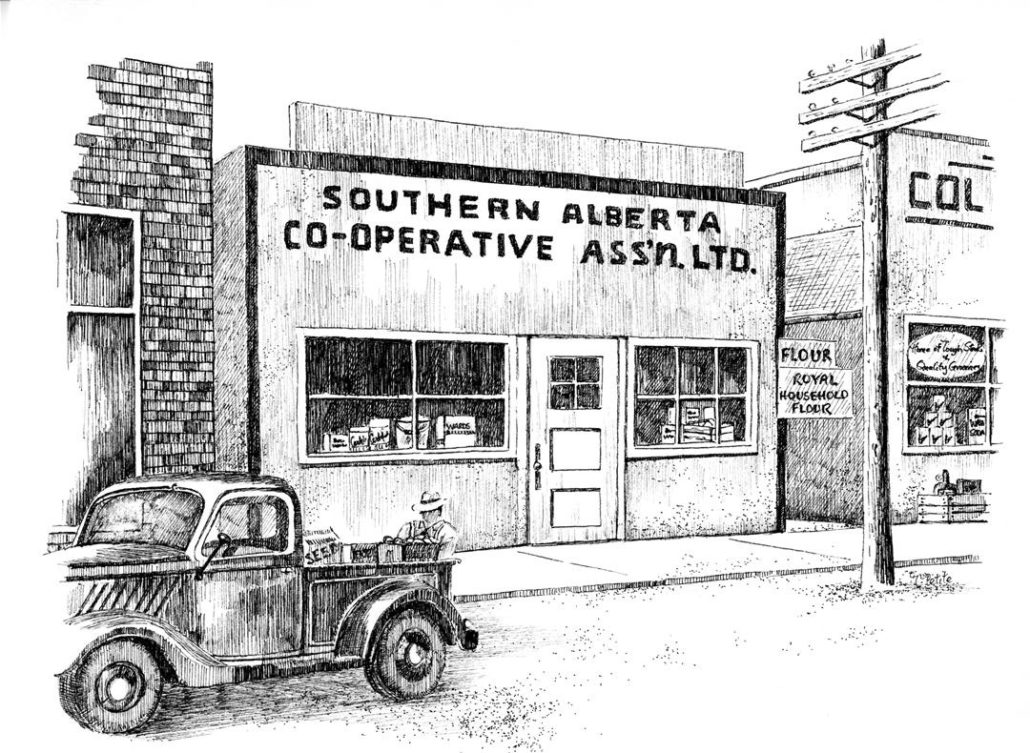
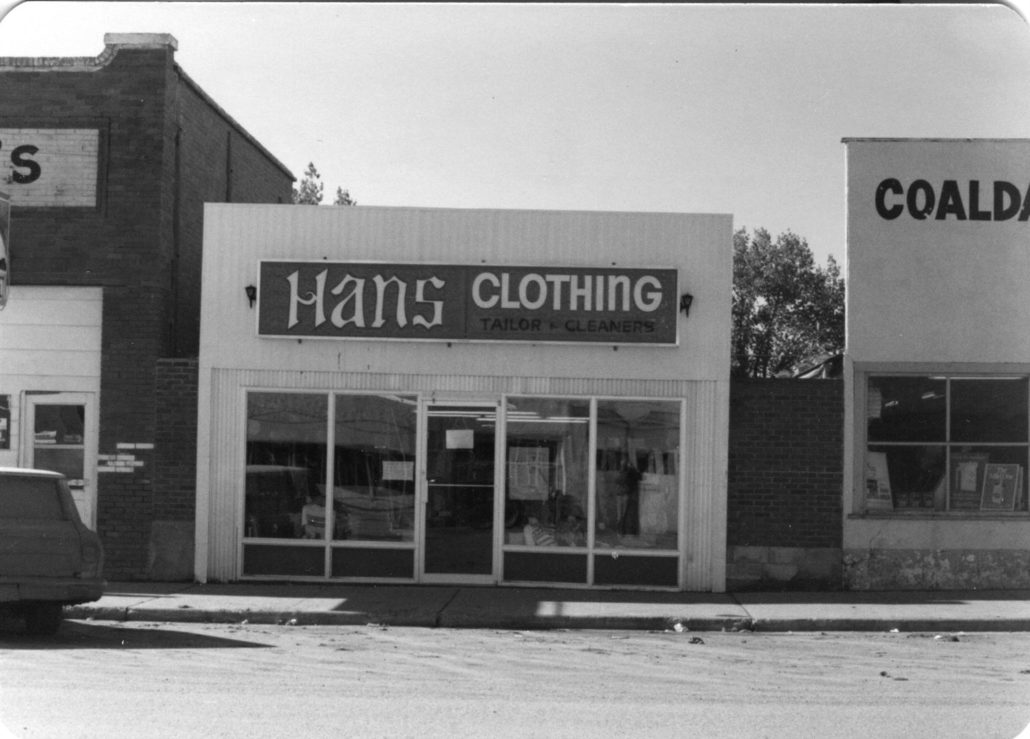
During the lifespan of The Southern Alberta Co-op Building a variety of retail shops have been its tenants, however its original use and location gives its story a unique flare.
The year was 1912 when an alfalfa growers association, comprised of hay producers from Lethbridge and Coaldale, was founded. This venture became known as Farm Products Ltd. Over the years a hay warehouse was built, scales erected and new processes, such as the grinding of alfalfa meal, were undertaken. The latter, required the construction of a new mill near the railway.
In July 1922, the Lethbridge Herald reported that the Farm Products Ltd. new office located by the mill was rapidly nearing completion. However, within two years the Southern Alberta Co-op Association, also referenced as the ‘Hay Pool’, had been organized to overthrow the company. The first local manager appointed, Jethro J. Leffler, occupied the former company’s office throughout the duration of the takeover negotiations. He eventually would acquire two hay sheds for the Co-op, the office with its retail department, two scales, stockyards and a coal warehouse.
He continued in this managerial role until 1928, when he transferred to the Cardston Co-op.
William F. Wahl took over from Mr. Leffler, as branch agent, a position he held for the next 18 years. It was during his tenure in 1940-1941 that the Southern Alberta Co-op office was relocated from Railway Street to its current location on Coaldale’s main street. An avid journal writer, Mr. Wahl documented in his diary, “ ….raising it on 60 foot timbers and moving it from the railway tracks onto a concrete foundation on main street….” He also wrote of the 1942 enlarging of the office and warehouse “… with Harry Proudley as carpenter.” In 1944 he penned, “Enlarged the office by moving the west side partition farther back, with the carpenter being William Foxall.”
Mr. Wahl passed away while still managing the Co-op. John Gossen took over the operation from 1947 to 1956. The Southern Alberta Co-op was relocated in 1966, to a much larger building and property at the west end of town. Today, Coaldale Lumber occupies that space.
In 1967 the original main street building was purchased and renovated by Hans and Elizabeth Pfeffel, who operated Hans’ Clothing and Dry Cleaning from this location until 1982. During their ownership, the Pfeffle’s upgraded the structure, including the hand-digging of a utility trench to enable the installation of water, and thus a bathroom, something it did not have since it was erected on the site several decades previous.
The Pfeffel’s retained ownership of the building following their retirement. They leased the property to several short term tenants over the next nine years, but in 1991 Hetti Bultina became a long term tenant, opening Crafts Unlimited and holding the lease for the next seven years.
Jean Lapointe purchased the property in 1998, operating Kin Folk Creations, a craft shop, for four years. From 2002 to 2006, her sister Mary Lynn Muhly occupied the space as Weddings by Kin Folk. When she closed her business, the property was purchased and extensively renovated by Stan K. Reynolds of Coalhurst.
Lease holders since 2008 have included Dan Forsyth operating Up Your Alley Ink Custom Tattooing, followed in 2010 by Justin Gulko and Chance Nordean’s Justinks House of Pain, another tattoo parlour. Currently, Wink Ext operates in the building.
#11 Proudley Service Station Building
1617 – 20th Avenue
Kustom Auto Body
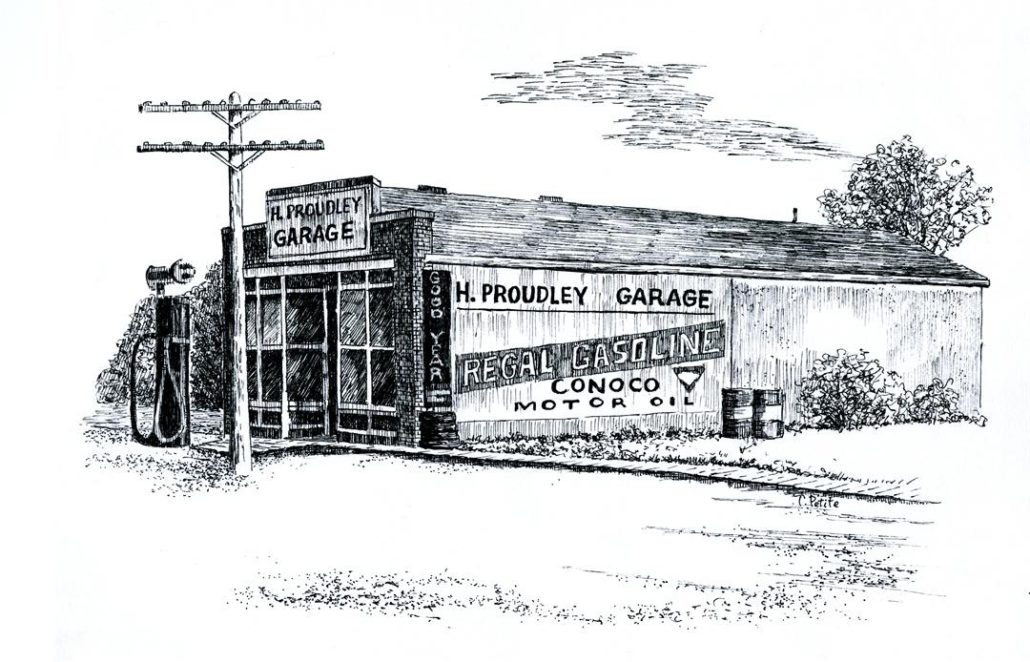
For close to 90 years this main street structure, which has been home to Kustom Auto Body for over four decades, has held a place in the heart of Coaldale’s business centre.
Although Land Title records indicate that the change of title for this property to Harry Proudley from Ella Linton of Cowley occurred in 1924, Lethbridge Herald news reports indicate the property was originally secured by Harry Proudley during the summer of 1921. Construction of a hollow-tile building, home to his new business Proudley Garage, was ongoing through the fall of that year. The report noted that it would be an addition to the village services upon completion. An article in the June 21, 1923, newspaper announced that Mr. James Dawson was engaged as an assistant to Mr. Proudley, Coaldale’s motor mechanic. However, the exact date of the building’s completion and the opening of what became known as Coaldale Motors remain unclear.
Nonetheless, what is evident from news reports is the success of the business. In October 1923, it was announced that Mr. Proudley had installed electric lights outside his garage. Fifteen years later, in the spring of 1938, he advertised his fully equipped garage for sale or rent. By the fall of that year, F.E. Johnson, having leased the Coaldale Motors building, was advertising he was prepared to undertake all motor repairs at his Grizzly 77 garage. Prior to leasing out his garage, Mr. Proudley had adjoined a large implement shed to the building where he began selling Massey-Harris farm machinery.
Records indicate that in 1938 John Graham Sr. acquired the International Harvester (IH) Agency. News reports reveal he had secured the combined machine shop and garage, relocating the IH operation to the shop area that had once held Mr. Proudley’s Massey- Harris equipment. The property remained under the ownership of Harry Proudley. In this new venture Mr. Graham was joined by his son-in-law Fraser Hodgson in 1942, and together they expanded the business to include the sale of used cars and trucks. Two years later, in 1944, John Graham Jr. joined the family business.
Land Titles indicate that in 1944 the property came under the ownership of Alexander Snowden and Edward G. Anderson – oil dealers – who within a year had sold to John M. Graham (Sr.), John S. Graham (Jr.) and Fraser Hodgson. Under the three-way partnership they continued to operate the 77 Garage and International Harvester Agency.
In 1948, Erie Graham moved to Coaldale and purchased his father’s portion of the business, making him a full partner with his brother John Jr. and brother-in-law Fraser. The trio continued to work together until 1955, when John sold his portion to the other two shareholders. Fraser Hodgson became the sole owner in 1956.
Later that same year, the business was purchased and operated by J.M. Williams, continuing as the International Harvester dealership and a service station, under the moniker “J.M. Williams Farm Supply”. The operation was managed by Steve Molnar, who would become a partner in the enterprise before it was sold in 1966.
The Proudley building’s chapter as a farm equipment dealership and gas station ended that year with the establishment of Ted’s Body Shop owned and operated by Ted Makishi. His venture lasted only three years, as the assets and business became the property of Dale Fujita in July, 1969. From 1973 to 1988, Kustom Auto Body operated under a partnership formed between Mr. Fujita and Peter Pauls Jr. Seventeen years later, the business founder would once again be the sole proprietor. Within ten years Dale turned the operation over to his sons Kevin and Jeff, who continue to build on the quality service and reputation of the business. Dale Fujita’s Kustom Auto Body signature has carried the notoriety of excellence from this location over the past 41 years.
Today, H. Proudley may only be a memory contained within news reports and history books. However, a peek between the Kustom Auto Body building and its westerly neighbor will reveal a portion of the original “Proudley Garage” mural, which was painted on the building’s exterior nearly nine decades ago. This signage is a true testament of the entrepreneurial spirit of Coaldale’s earliest business owners.
#12 Coaldale Heritage Mural – Fire Protection Service
1507 – 20th Avenue
Coaldale and District Fire Hall
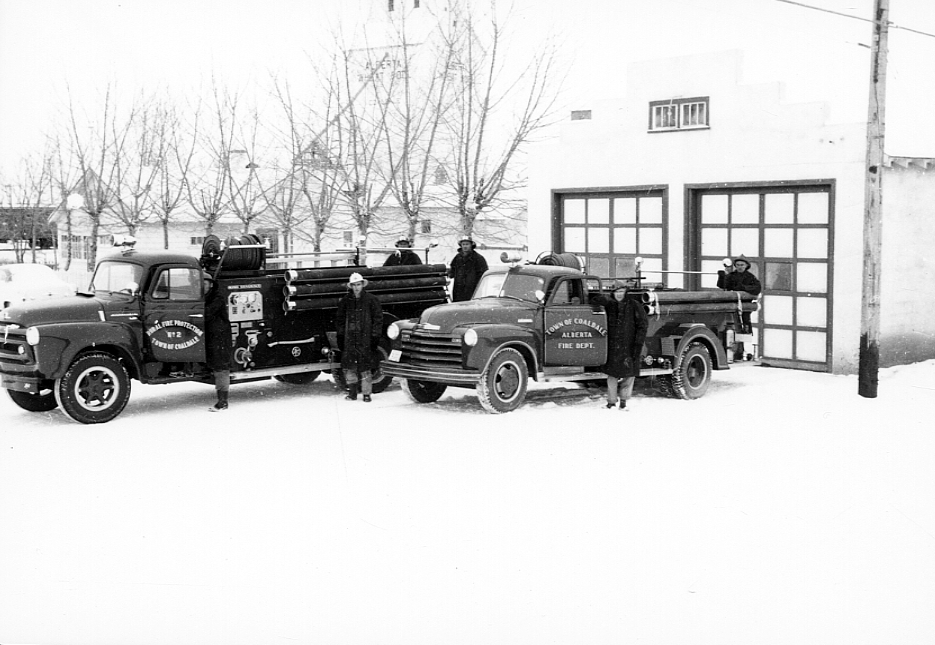
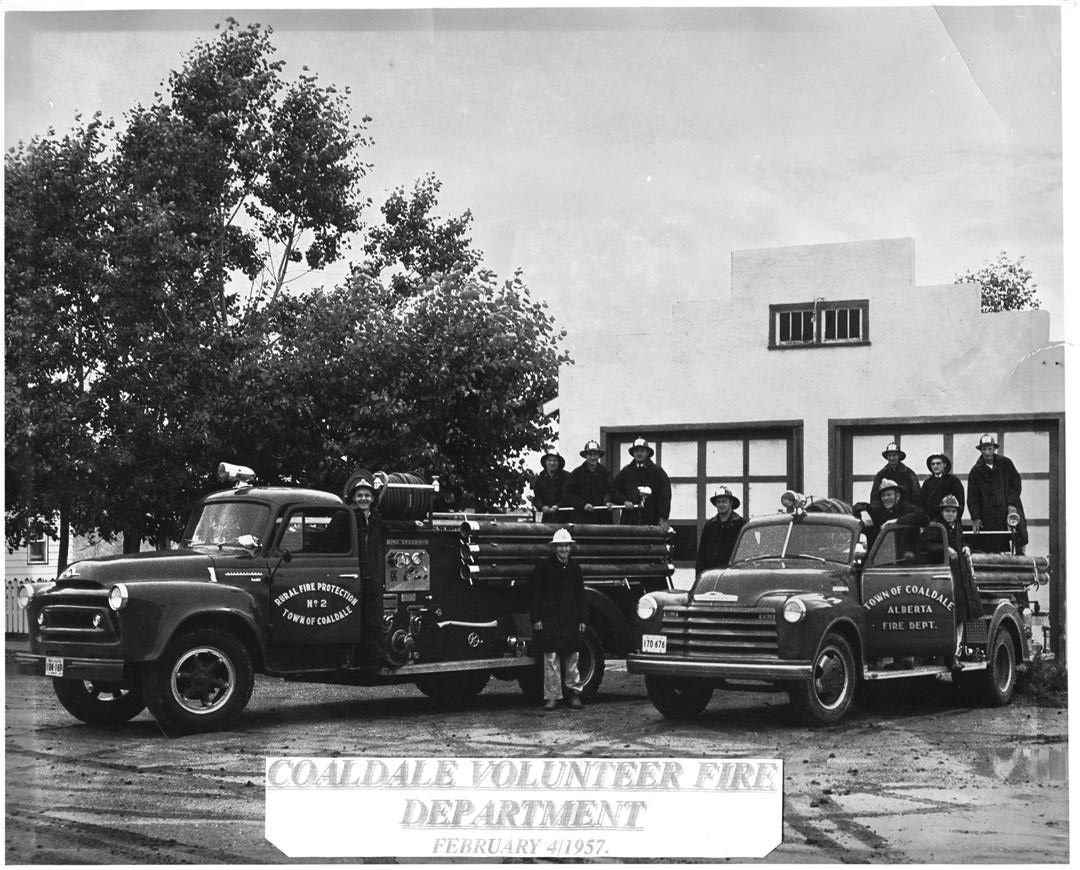
Fire protection services were just as crucial a component of rural life during the settlement years as they are today. Unlike the top-rated equipment and trained personnel of modern time, however, pioneer firefighting tools and methods were unpredictable. Service often failed at the most vital moment, leaving panicked folks scrambling for buckets and a water source.
From the time settlers arrived to both Coaldale and the surrounding district, fear of fire was a constant reality. Grass fires in the rural areas were controlled by ploughing fire breaks with farm machinery. Within the village limits, residents of all ages would run to a fire scene to literally pass the water buckets in an effort to extinguish flames. Most often the loss of property was significant.
Although decades of village council minutes clearly indicate that community leaders debated the need to acquire proper firefighting equipment, it was not until 1948 that the council made a decision. It purchased a two-wheeled chemical cart that proved to be reliable only part of the time. Soon after the incorporation of Coaldale in 1952, the town purchased its first bona fide pumper. This purchase coincided with the installation of underground water and sewer distribution lines. During the fall of 1953, the shiny “fire engine red” 1953 Chevrolet was driven from the manufacturing plant in Woodstock, Ontario, to Coaldale by Steve Molnar and Fraser Hodgson.
Legions of local volunteers were prepared to step up as firefighters, taking on responsibility for manning the pumper. The first call came on May 24, 1954, after fire broke out at the John Dyck farm, one mile west of Readymade School. An incident assessment following that response quickly revealed considerable training was required in both the use of the new pumper and of fundamental firefighting techniques.
Over the next 31 years, the development of a cohesive firefighting unit came under the direction of Fire Chief George King. Mr. King was originally installed by town council as a volunteer leader and was hired as a full-time chief in 1975.
Early in Chief King’s tenure, community leaders expressed concern with municipal fire trucks and personnel leaving the town unprotected as they responded to emergency calls within the district. Between 1954 and 1956, following many planning meetings involving local leaders and district farmers, the Town of Coaldale Rural Fire Protection Association was established. The association was the first of its kind in Alberta to be equipped in compliance with insurance underwriter regulations. Fundraising efforts kicked into high gear for the purchase of a second fire pumper, specifically for use in the rural district.
Over the next 14 years, the Rural Fire Protection Association and the pumper truck it had purchased were instrumental at every fire in the district. Firefighters became more proficient with each alarm, and their tenacity towards protecting rural residents’ properties was legendary.
In 1970, the Town of Coaldale Rural Fire Protection Association was dissolved. In a move to establish its own rural firefighting service, the County of Lethbridge No. 26 purchased the pumper. Two years later, the Coaldale and District Fire Services was created with the signing of a 50-50 cost share agreement between the two municipalities. They agreed to provide fire protection services within a 400 square mile radius, east-west between Broxburn and Chin, north to the Oldman River and to the south end of the Lethbridge County.
In 2007, the Town of Coaldale Mural Committee commissioned local artist Barry Overn to paint a heritage mural on the exterior west wall of the Coaldale and District Emergency Services building. The mural depicts the Rural Fire Protection Association’s origin by replicating a 1957 photograph as it appeared in the Western Producer as part of a feature article on the establishment of rural firefighting in Western Canada. The painting was slightly embellished to include the town’s original ambulance, a 1952 Dodge wagon purchased second-hand in 1959. This change incorporated an equally important segment of Coaldale’s emergency services’ history into the painting.
Today, the Coaldale and District Emergency Services continue to provide fire protection for both the town and south-east area of the County of Lethbridge.
#13 Graham’s Garage Building
1412 – 20th Avenue
Graham’s Garage
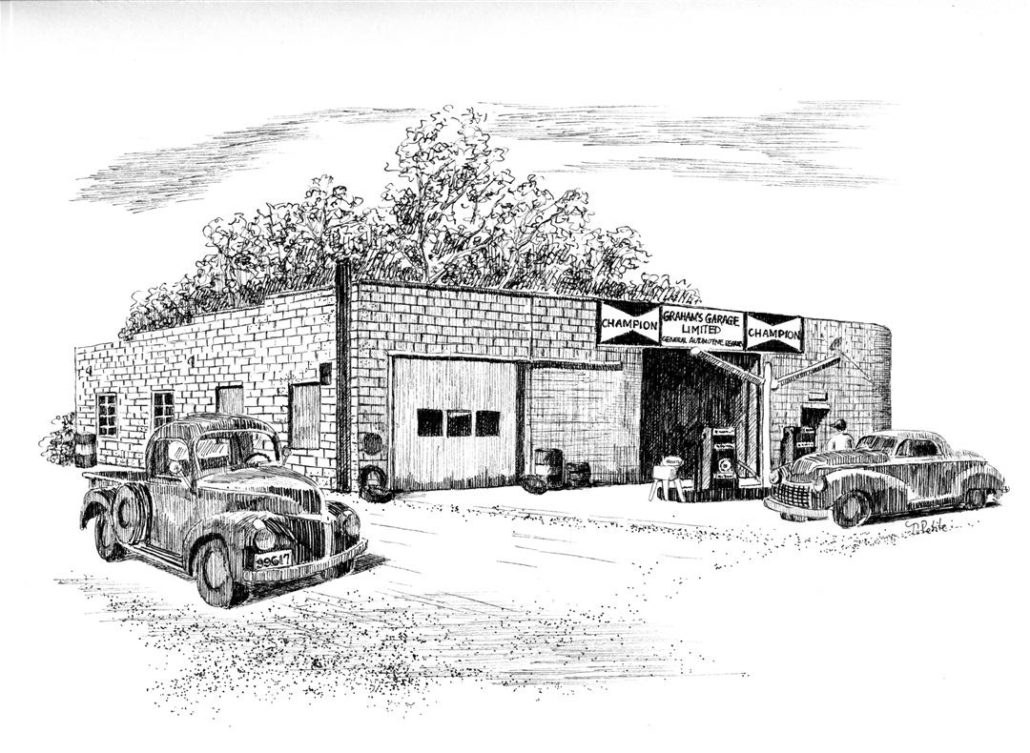
In 1947 Matt Slovak purchased land at the east end of Coaldale and undertook the construction of a 40 by 60 foot block structure. This building housed Highway Motors, a full service gas station. A self-proclaimed “jack-of-all-trades”, Mr. Slovak also did welding and electrical work.
Five years later John Samuel Graham along with his son-in-law Fraser Hodgson and son Erie, who had relocated his family to Coaldale after his 1944 military release, purchased the Slovak business and property. Under the three-way partnership, Graham’s Garage was established. On April 5, 1955, the business came under the partnership of brothers-in-law Erie and Fraser, and just over a year later, on May 31, 1956, Erie Graham became sole proprietor of Graham’s Garage.
He operated under the White Rose service station banner for the next 11 years. In 1962 Shell Canada acquired the Canadian subsidiary of the National Refining Company, which owned White Rose, and all applicable stations were re-branded with the Shell insignia. The brazen yellow shell sign would mark the business entrance until 1976; nine years after Erie had sold his interest in the garage to two of his employees.
Bert Vanderwal joined the Graham’s Garage staff in 1958, followed seven years later by George Van Bostelen. The pair of skilled mechanics established a partnership, and in 1967 bought out the business’s namesake, who was headed for retirement.
Continuing to operate as Graham’s Garage, Bert and George managed a flourishing business. In 1975 a 50 by 100 foot service bay addition was constructed to meet increased customer demand. The following year the Shell franchise was replaced with a Turbo service station contract. In 1985 George procured Bert’s share to become the sole proprietor of the business and the building.
For a nine-year period between 1997 and 2006, the building was occupied by Richard Wielenga, who operated the NAPA AutoPro service station. In 2006, following in his father’s mechanic’s footsteps, Conrad Van Bostelen re-established Graham’s Garage under the familiar banner launched more than 60 years previously.
#14 The Town of Coaldale Town Office Building
1714, 1716 – 20th Avenue
Klassen Building
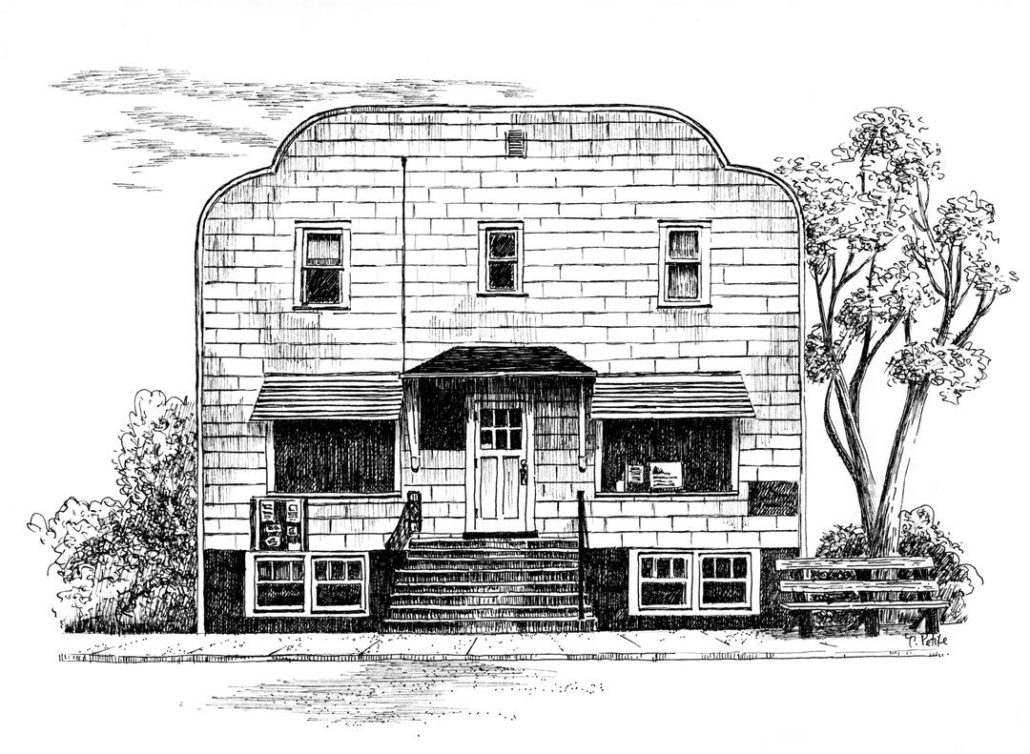
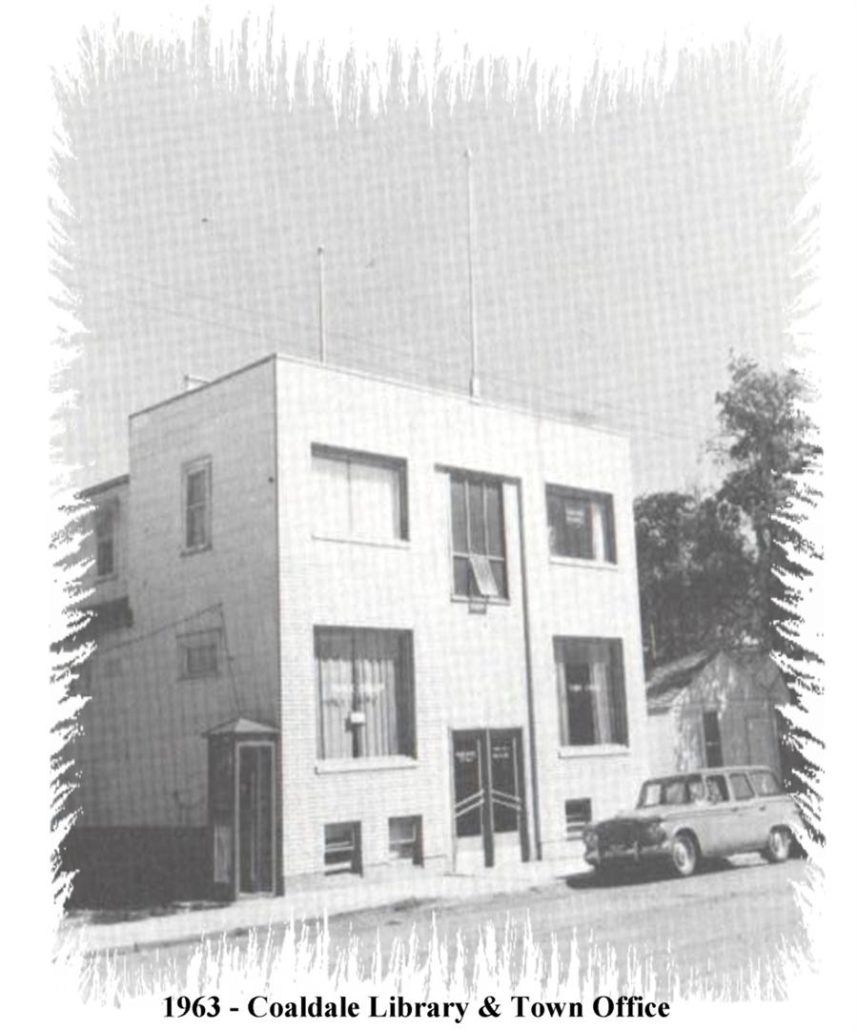
Steeped in community history garnered over the past 60-plus years, this unassuming main-street structure has been home-base to various forms of commerce, professional and governmental headquarters. It has, in addition, served as home to school classrooms and numerous town residents.
Built in 1947, the two-storey building was constructed by the Coaldale Community Council to originally accommodate the community library and village office. By the time it was officially opened in the fall of 1948 it also contained the police station, jail and court house. The municipal government office was established on the main floor of the tri-level complex, along with community meeting rooms. In 1953, under an agreement with the community council the Town of Coaldale became the caretakers and owners-in-trust of this property. Coinciding with the change in ownership an addition to the building, along with extensive interior renovations were undertaken.
The space served the municipal government’s needs until the mid-1970, when managing the requirements of a growing community required substantially more administrative office area. During that period town officials investigated land availability and developed blueprints for the construction of an expanded municipal office. By 1976, the Town of Coaldale was headquartered in a modern facility on 18th Street, which today is home to the Barons Eureka Warner Health Unit.
In 1976 Elsie and Herb Klassen acquired ownership of the building, operating their numbered company 20400 Alta Ltd. on the building’s east side. With the relocation of the municipal offices the main floor space was renovated to accommodate other enterprises simultaneously. Included was a hair dressing shop on the east-side of the building operated between 1976 and 1980 by Cecile Frache. Her tenure was followed by 12-year tenant Josephine Ebner proprietor of the Hair Hut. During the same time period an area was occupied by Hetti Bultena owner of Crafts Unlimited.
In office space developed on the west-side of the main level, Henry’s Chocolates, a wholesale distribution outlet held the lease from 1983 to 1986. The Coaldale and District Chamber of Commerce took over the location for a seven year period from 1998 to 2005. They were followed by current leaseholder Evans Trucking, which has remained in that location since 2007.
The top level of the building has an interesting history unto itself, having housed a classroom for local students during the 1950-51 school term while the R.I. Baker School construction was underway. Shortly after, this space became the original home of the Barons-Eureka Health Unit, who remained for 24-years until cramped quarters forced relocation to a larger office in 1975. From that point forward the upper level leaseholders have leap-frogged between residents and business operators. Included were Elsie and Herb Klassen’s Century 21 Real Estate between 1981 and 1986, followed in 1999 by Roger’s Sugar, which has been renamed Lantic Inc.
If a record of the activities that went on in the lower level of this building had been maintained it would provide valuable insight into the growth of a community. For 25-years, between 1947-1972 Coaldale’s police department, local jail and court house operated from this site.
Interestingly, stashed within all of these law enforcement and justice areas was the community library. Vacant for several years following the construction of a modern police station, the entire space was eventually occupied by Ian and Jenny Clapton who operated a bakery between the years of 1977 to 1979.
For the past 30-years however, this space has accommodated primarily two types of ventures, the community thrift shop and the food bank. For a decade between 1979 and 1989 Ruth Wyton operated the Coaldale Community Thrift Store, followed by Georgina Cannady as owner operator for a brief period of time, before the store was closed in 1990. Five years later, the Coaldale Food Bank opened its doors, under the direction once again of community-minded Ruth Wyton. She remained as manager for six years, followed in 2001 by Vaughn Caldwell.
#15 Original Village Office Building
1908 – 18th Street
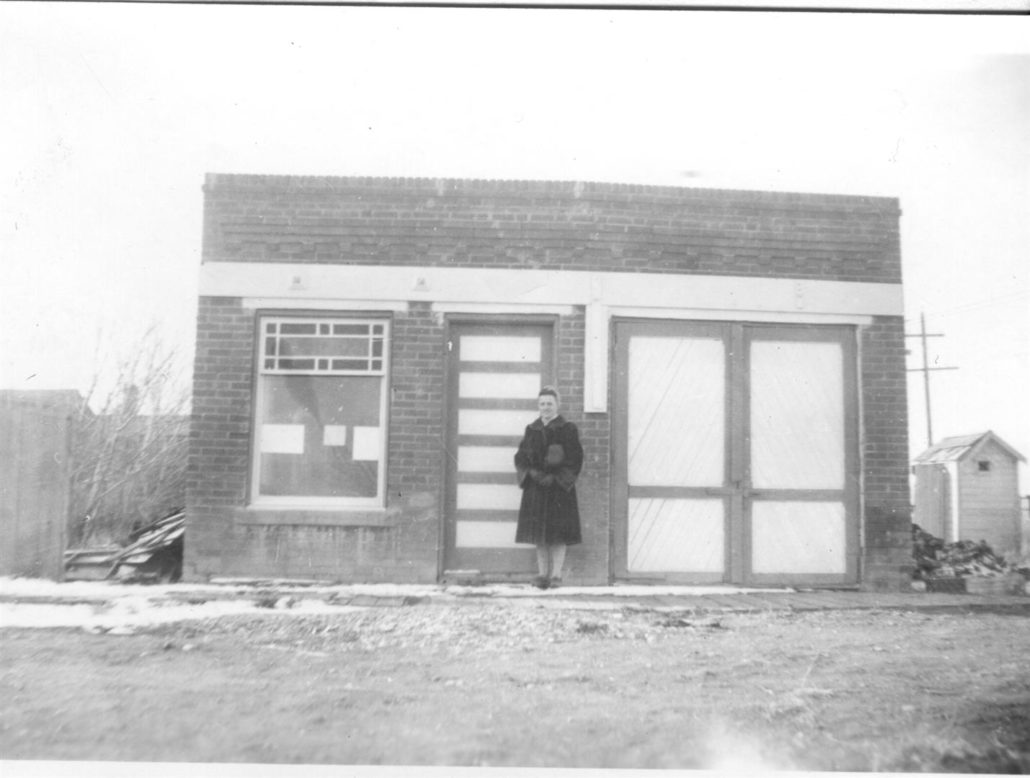
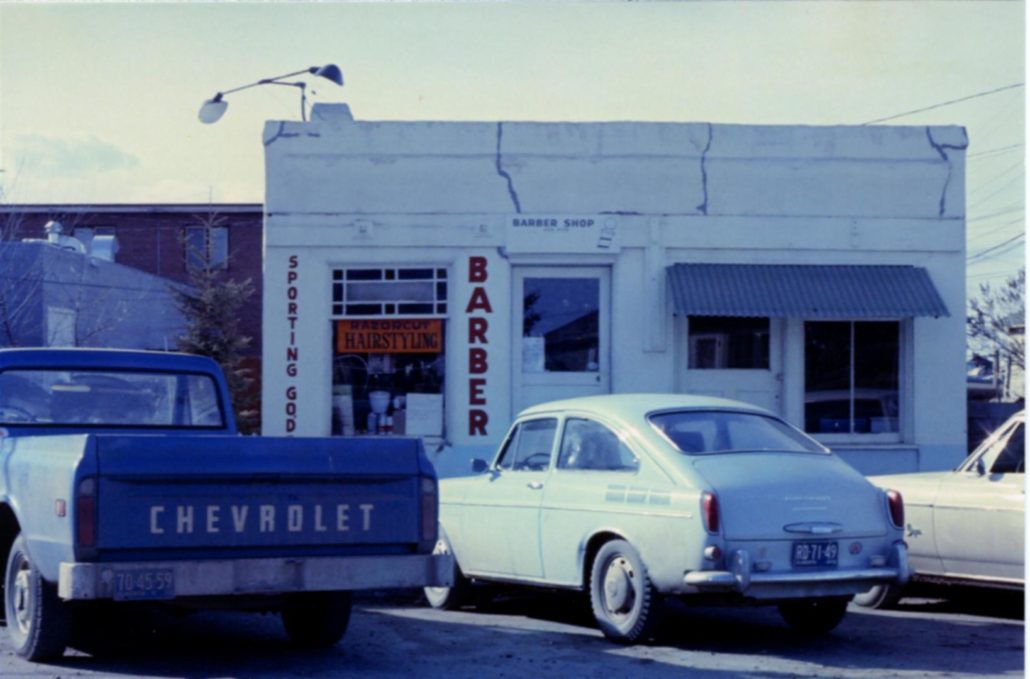
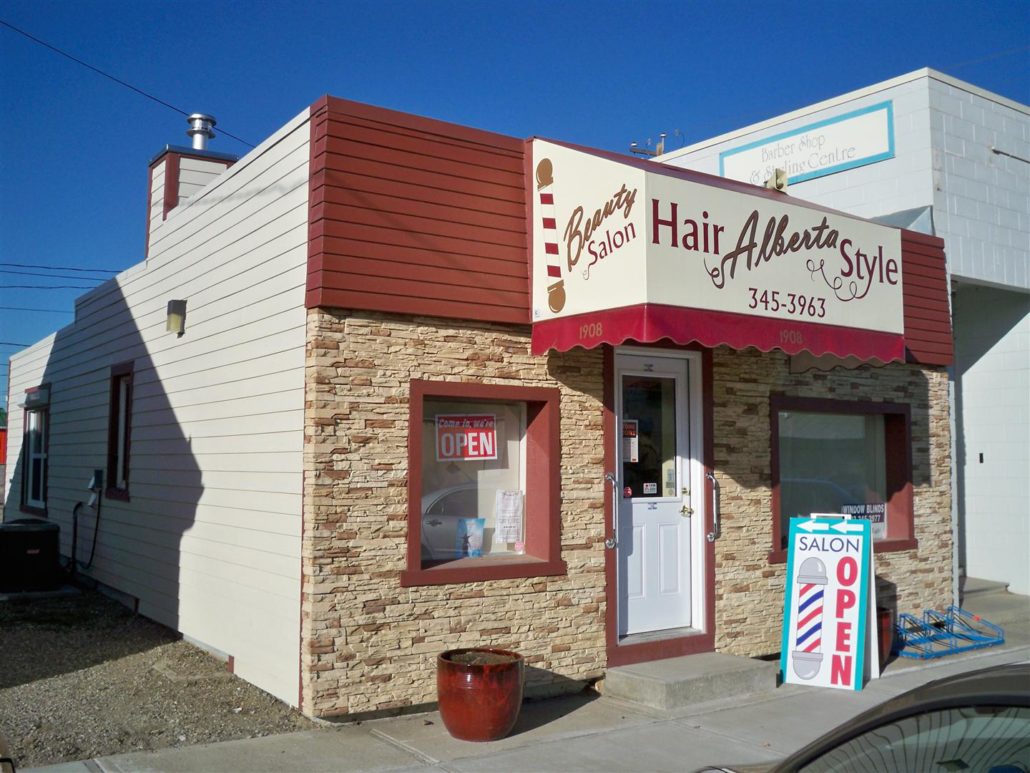
This small wooden structure established in 1910 has seen more than its share of reincarnations over the past century. Built by Harry A. Suggitt, it was originally used as a ‘scale house’ weighing wagon loads of grain for area farmers.
According to Alberta Land Titles the building was purchased in 1913 by Charles C.K. Nourse, the manager of the Bank of Commerce and four years later came under the ownership of that bank. No documentation as to what the building was used for during that time period has been located. However, sometime between 1917 and 1919 the building returned to the proprietorship of Estelle Suggitt wife to Harry, who in 1919 sold the property to Robert Jones, who operated an equipment repair shop from this location until 1922.
By 1922, the Village of Coaldale established a fire hall and dog pound in an addition to the structure. Records are unclear as to who owned the building during the years following, for in 1926 land titles indicate the property was owned by the Crown, under the tax recovery program.
In early 1930 this building became a multi-municipal government facility. Half the capacity was dedicated to the Village of Coaldale administration office and meeting place for the local school board, with the north portion housing the ‘fire call station’ complete with a hand-pump fire wagon bay. In 1940-41 the fire wagon was replaced by a fire truck, which was stored in a nearby garage, thereby providing available space for the community’s first library.
Following the 1947 relocation of the civic government office and library to a new main street location, the property was purchased by P.L. Thiessen, with the space utilized for his shoe repair enterprise.
On November 6, 1949 George Murakami relocated his barbershop to this site, where he would remain for the next 27 years. A bachelor at the outset of his career in this location, he would eventually have an addition constructed on the west end of the structure, creating living quarters for his bride and growing family and operating George’s Barbershop street side. In 1958, as an avid fisherman and sports enthusiast, Mr. Murakami reconfigured the barber shop to add retail space for fishing gear and sports equipment. This thriving business remained in this location until 1976 when he moved his operation into a new two-story masonry building he had constructed on the neighbouring property.
George used the old barbershop space occasionally for storage, but it remained largely vacant until 1979 when the Foxall brothers opened a Radio Shack sales and repair shop. During the early 1980’s they moved out and Lloyd Abel ventured into the bargain shop business, selling furniture and antiques from the location. By the mid-1980’s another renovation changed the site into Sid Harvey’s taxi stand and pop shop.
In 1992, Armand Segouin purchased this tiny shop, in partnership with Darcy James Lee. A decade later Armand and his wife Alberta purchased the building outright. From 1993 through to 2009 many different ventures were housed in this location. Some of which were, a second-hand store, computer graphics outlet and for a time a Teen Centre, operated by the Coaldale Youth Foundation supported by the Town, Family and Community Support Services (FCSS), and private donations.
In 2009 its true calling as a place of grooming reemerged when the Segouin’s renovated and re-established a barbershop, complete with a singing barber, and beauty salon on the premise under the business banner Hair Alberta Style. Today, this building has been incorporated into the adjacent building to form Three G Eatery restaurant.
#16 Dr. Epp’s Medical Clinic Building
1802 – 20th Avenue
Sunny South News
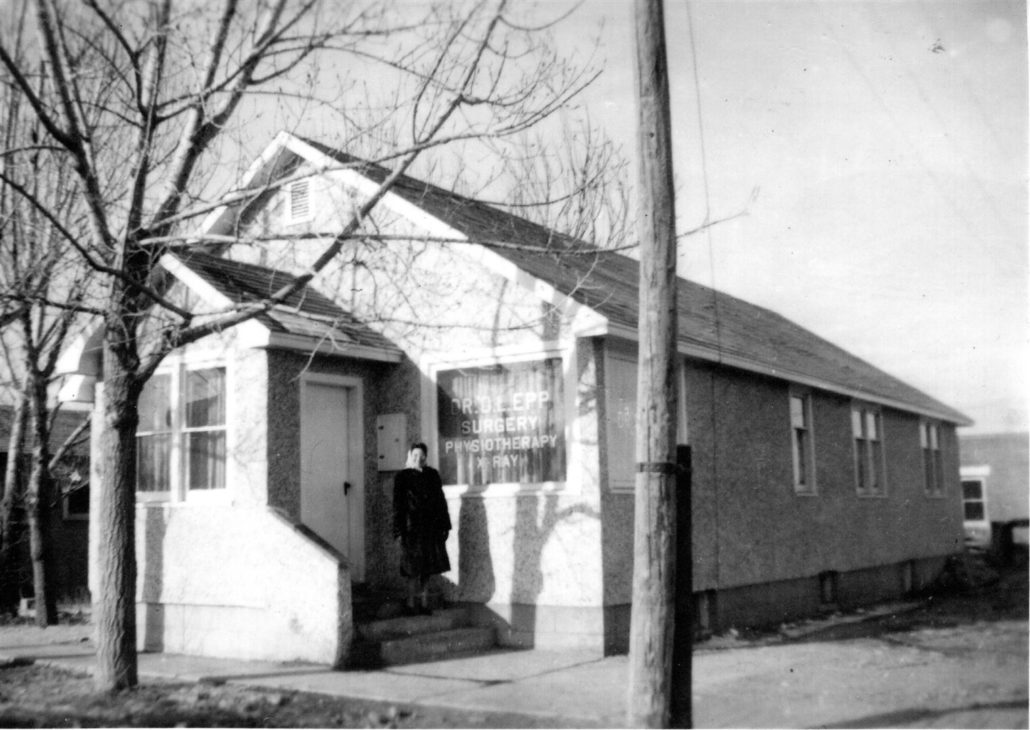
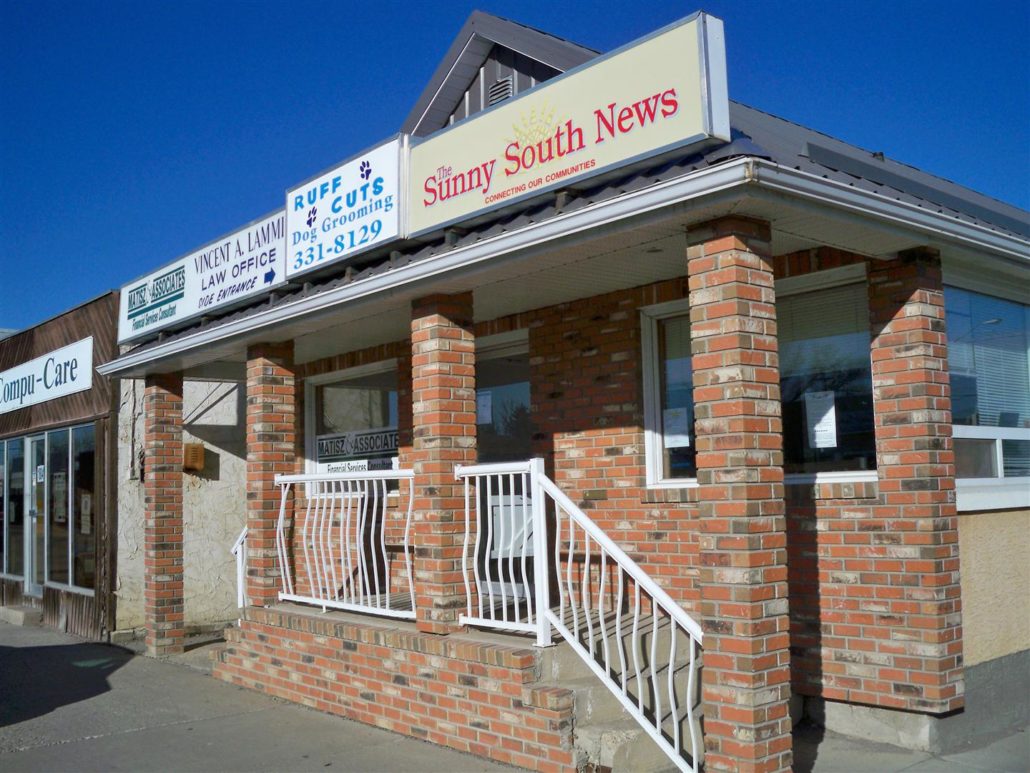
In 1936 when Dr. David Epp, Coaldale’s first physician, was forced to relocate his practice from the Standard Bank Building, he envisioned a partially-used structure on the northwest corner of 20th Avenue and 18th Street as the perfect space for a medical office.
Long entrenched in local history, this structure was built for commercial investment by Welshman Robert Jones in 1919. His original tenant was Harry A. Suggitt who opened the Suggitt Land Agency and Insurance in February 1919, operating for approximately six years. Active in a variety of community causes, it wasn’t long before Mr. Suggitt attracted other leases to the well located Main Street building.
The newly established Coaldale Commercial Club became a tenant in May 1919, and the Farm Products Company, complete with weigh scales out front, opened that September. Within two years, the Ladies Aid Society had erected a women’s restroom in the Commercial Club’s portion of the building.
By the spring of 1923, it was reported that Mr. Suggitt had run into financial difficulties. He subsequently sold his farm to Robert Jones and moved his family into newly renovated living quarters within the Suggitt Agency building. In January 1926 he relocated to Vancouver, followed shortly thereafter by his family, leaving behind two decades of community and business involvement.
With his property finally vacated of all occupants, Robert Jones took up residency, living in the rear portion for the next decade. It was at this time when Dr. Epp approached him with a business offer.
In the Coaldale Gem of the West history book, Dr. Epp recalled his dealings with Robert Jones.
“One day I approached him to see if he would rent the two front rooms to me for an office. After thinking for awhile he said the rent would have to be at least $15 a month. I agreed to that price and Mr. Jones moved the furniture into the next room which had been a living/dining room at one time.”
During the summer of 1936, Dr. Epp opened his new medical office in the south portion of the building, complete with waiting, consultation and examination rooms, and the hallway serving as the dispensary area. In 1939, the building was raised and a proper basement foundation was poured. Following the death of Robert Jones, the title of the property was acquired by Dr. Epp.
In late January of 1943, Dr. Epp’s thriving practice was rendered a severe blow after a fire ravaged the entire building. With the help of the Coaldale Mennonite Health Society, the organization that had persuaded him to come to the community 10 years earlier, Dr. Epp rebuilt his clinic on the same foundation. He continued to practice medicine from this location until 1947, when he and his family relocated to British Columbia.
For the next 29 years, the space affectionately referred to as Dr. Epp’s continued to function as a medical clinic. From 1947 to 1970, it was occupied by the medical doctors contracted under the Coaldale Mennonite Health Society. The group had gained title to the property in 1950. Between 1970 and 1976, physicians under the umbrella of the Campbell Clinic continued to serve the medical needs of Coaldale residents from this location.
Dave Neufeld and Murray Tofsrud purchased the property in 1976, operating DNR Real Estate and Neufeld Insurance from the premises until 1988. During that time they reconfigured the interior space to accommodate other business ventures, including Lammi Law, Vincent Lammi’s law practice, operating from an office in the north portion of the building since 1984. In 1985 The Sunny South News moved into the south-central portion of the building and today is situated in the south-east offices.
Local entrepreneur and businessman Cal Larson held title to the property between 1988 and 2001. Current proprietors Elsie and Herb Klassen, holding title to the building since 2001, operate 20400 Alta Ltd. from the west central office.
Additional lease holders operating businesses within the segmented space include Matisz and Associates in the south-west front office (2006), and Jessica Matthies -Vreeken, owner of Ruff Cuts dog grooming, in the rear east office (2008).
#17 McLennan Building
1804 – 20th Avenue
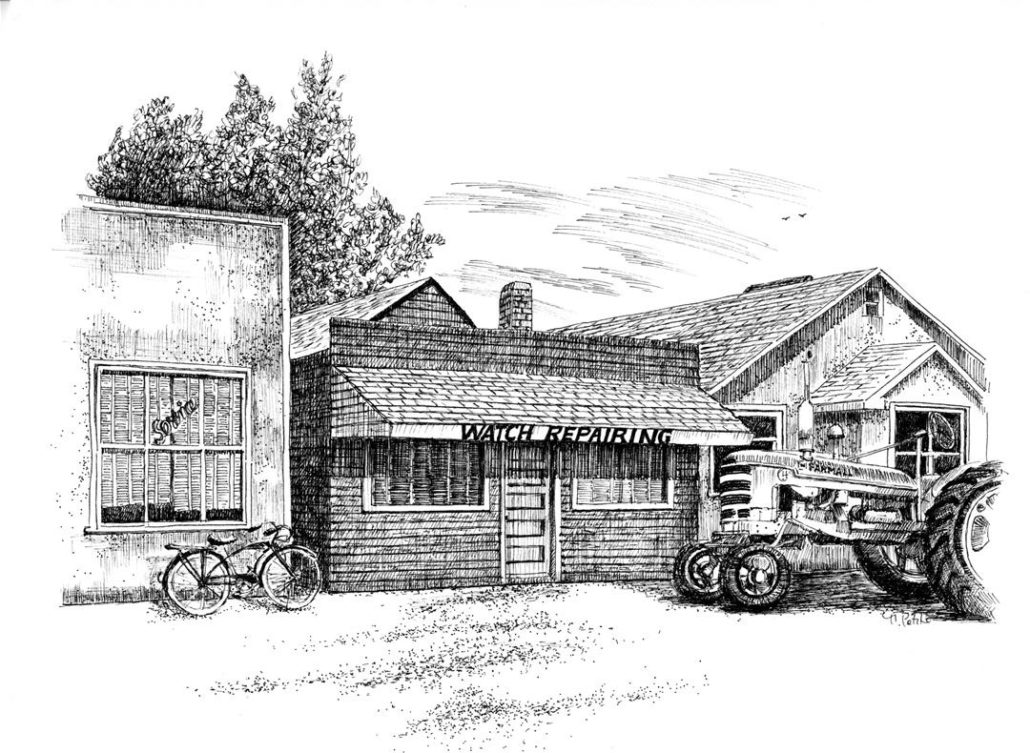
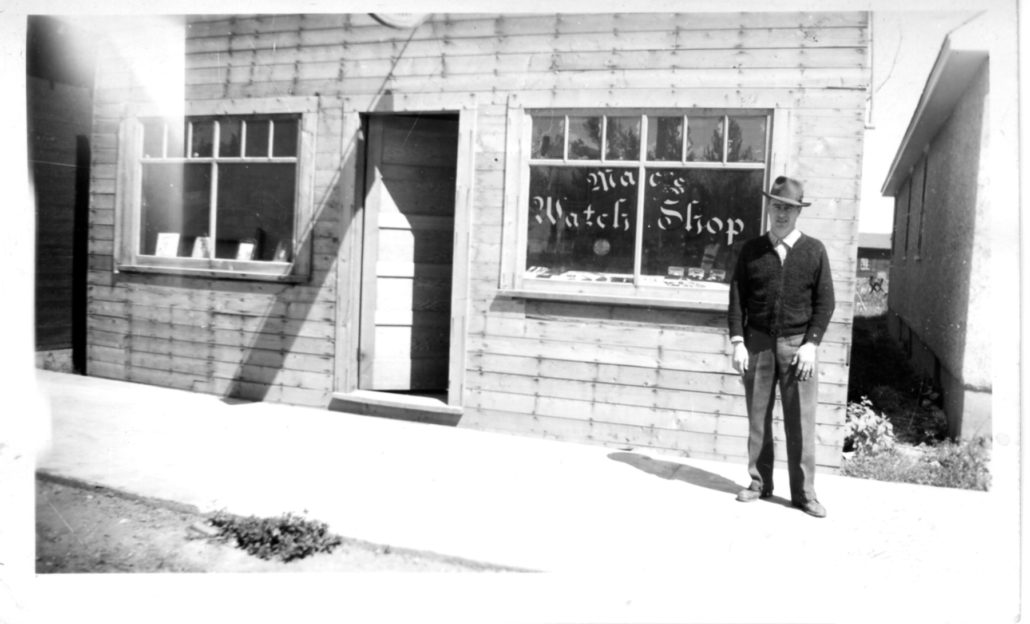
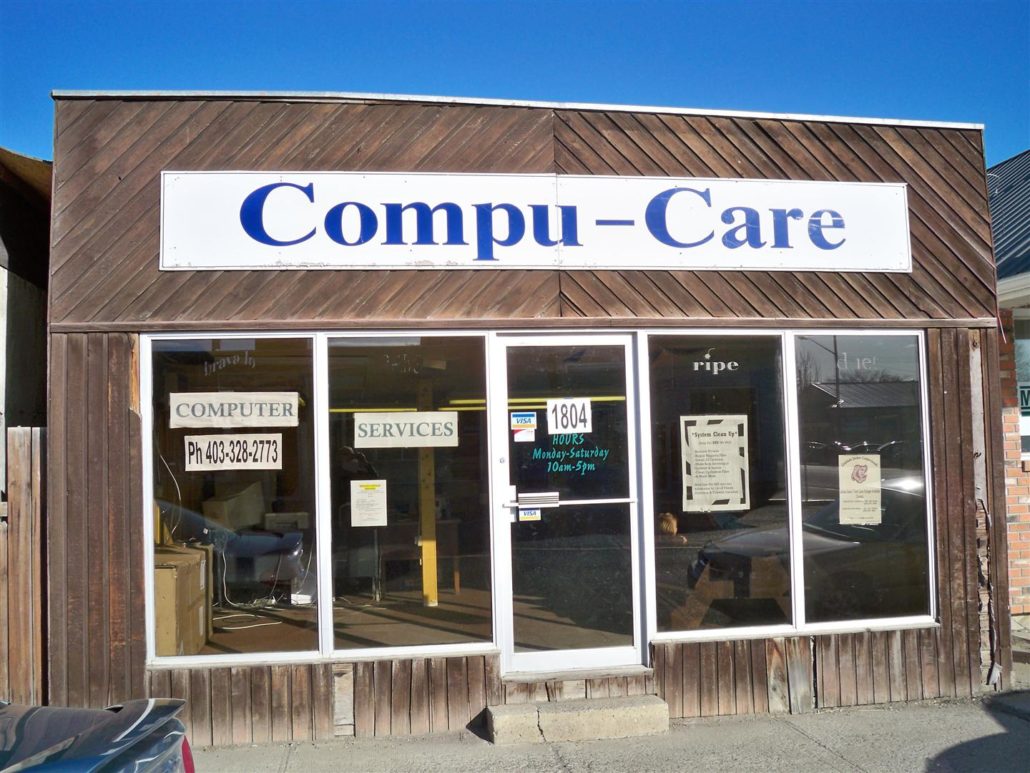
Although it is unknown exactly when this building was constructed or by whom, it is documented that in 1946 Frank Isaac operated a photography studio within the confines of a much smaller space than exists today.
Before the end of that year Jim McLennan was operating a watch repair business in the front portion of the structure. He had constructed an addition to the north end, enlarging the space to accommodate his family in a residential setting. The McLennan’s conducted their professional and personal lives from this main street locale until 1954 when the building was sold to Ethel and Albert Downey.
For the next 19 years Ethel Downey operated a popular hair salon in the storefront portion, while the couple occupied the rear section as their residence.
In 1973, Earl Foxall and Associates, who operated the Coaldale Development Company over the next five years from this prime office location, purchased the building.
In 1978 the elder Mr. Foxall sold the McLennan Building to a partnership formed by his three sons Doug, Wayne and Don. The latter two siblings operated a Radio Shack outlet in the building until 1986. The oldest brother Doug, in joint tenancy with Jack Derksen, operated an accounting practice in a portion of the building between 1980 and 1986.
While the Foxall brothers retained ownership of the building, several leaseholders operated businesses from the site over the next two decades. Included were Lorne and Reg Osmond who managed Gem Photo Shop for seven years, 1986 – 1993, before turning over the business – complete with company name – to Ron Schreiber, who continued the venture for an additional four years.
Between 1997 and 2002 various entrepreneurs tried their hand at many different endeavours, none of which lasted and the building remained vacant much of the time.
In 2002, however the building was revitalized as a retail outlet by Karen Cannady, who opened The Stork’s Nest, a popular gently used baby clothing and accessory outlet.
Five years later, in 2007 building co-owner Wayne Foxall relocated his Lethbridge business to the Coaldale shop, continuing to operate Compu-Care Computer Services, in partnership with his daughter Farra. Today, the building is home to Town & Country Locksmiths.
#18 J.J. Loewen Printing Office Building
1806 – 20th Avenue
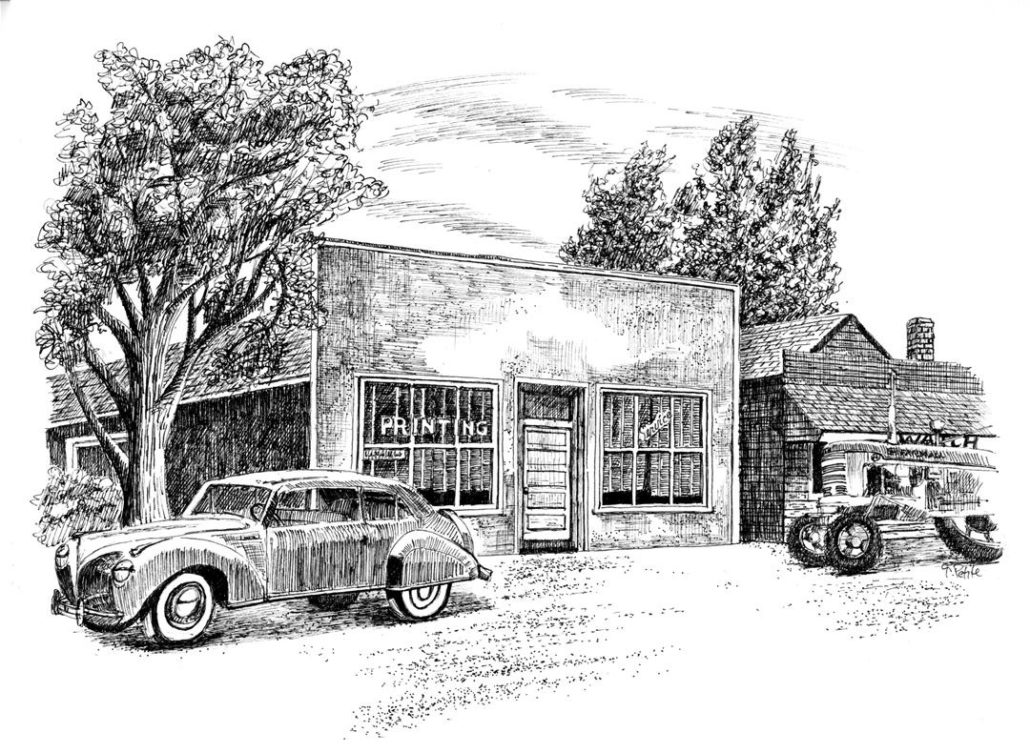
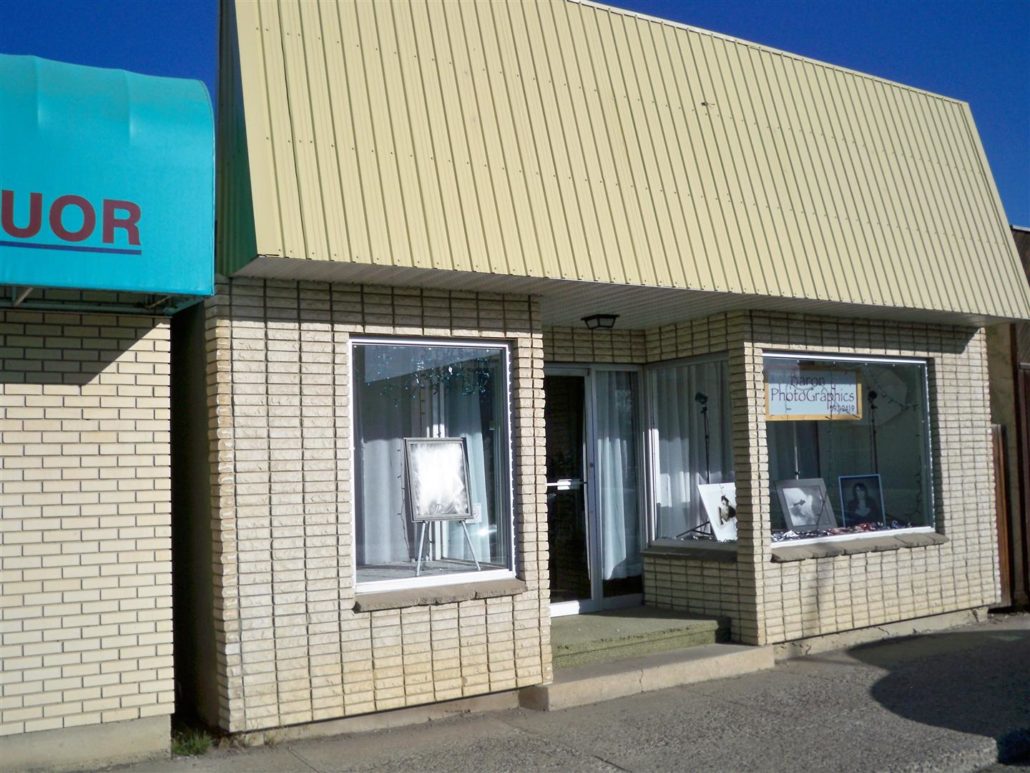
From the clacking of lead type to the clicking of camera shutters, if the walls of The J.J. Loewen Printing Office Building could talk, quite a story would unfold.
Coaldale’s first printer, Jacob J. Loewen, opened his business in 1940 using a case of type that he purchased for $45 and a printing press he could hold on his lap. Within four years he managed to buy a used linotype machine and relocate the operation to a new building constructed on property owned by Dr. Epp. By 1946, J.J. Loewen held full title to that land and building from which he ran his print shop for the next 13 years.
As a Christian and a Canadian, with a focus to “fight the war with ink and paper” his original work was religious tracts printed in German for circulation in prisoner-of-war camps throughout Canada, the United States and abroad. Through the years he printed bible portions, religious tracts, and over 3,000 copies of the Children’s Bible in German. By the conclusion of WWII his mandate was revised “to integrate the people of this cosmopolitan town.” The population of about 1,000 residents was made up of English, Mennonite, Japanese and other emerging cultures. He kept them informed about the tax system, local government and general news.
By 1957 The Coaldale Flyer, Lethbridge Northern News and the Raymond Recorder were all rolling off J.J. Loewen’s backroom press. Two years later, the Flyer and Northern News publications were combined and rebranded The Sunny South News – serving Coaldale, Picture Butte and the communities within the County of Lethbridge, very much as it does today.
In 1960 the well-established print plant and newspaper business, along with the property came under the ownership of J.B.R. Staddon and his son Bert Jr. The operation was a Staddon family affair. Bert Sr. was responsible for the advertising, Bert Jr. typesetting and printing, mother Rose for looking after the accounting and retail sales. The six school-aged Staddon children all worked in some aspect of the newspaper business to ensure deadlines were met and the weekly edition ready for delivery each Thursday.
Following a fire in January 1966 that destroyed all of the files and much of the printing equipment, the Staddon’s continued as publishers, with the publication coming off the Taber Times press. In 1970, Times publisher, George Meyers purchased the business and continued operating from this location over the next three years before relocating to a store-front office in the former Farmer’s General Store Building on the south-side of the main street.
In 1973, the smell of printer’s ink that once wafted through every nook and cranny of the J.J. Loewen Printing Office Building somehow was eliminated when the property was purchased by Andres Transport Ltd. and the space transformed into the clothing retail business of Herb Fletcher’s Men’s and Ladies’ Wear, operated by Herb and Joan Fletcher.
The Fletcher’s quality garment store was jointly operated for 18 of its 20 year existence, with Joan taking over full responsibility during the final 24-months, following Herb’s untimely death in 1991.
For the next 13-years the focus of the businesses that continued to operate from this location was retail-based, with Kelli Tuttle’s Country Rose Boutique gracing the space from 1993 to 1998. A brief vacancy period followed before Karen Cannady opened The Stork’s Nest, a quality used baby supply store in 2002. Since 2006 the business space has been dedicated to Barons Photographics, operated by professional photographer James Baron.
